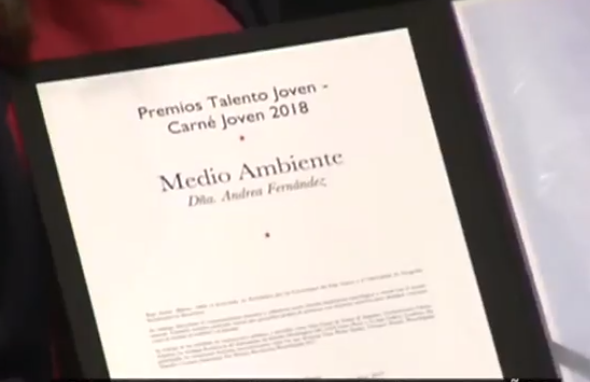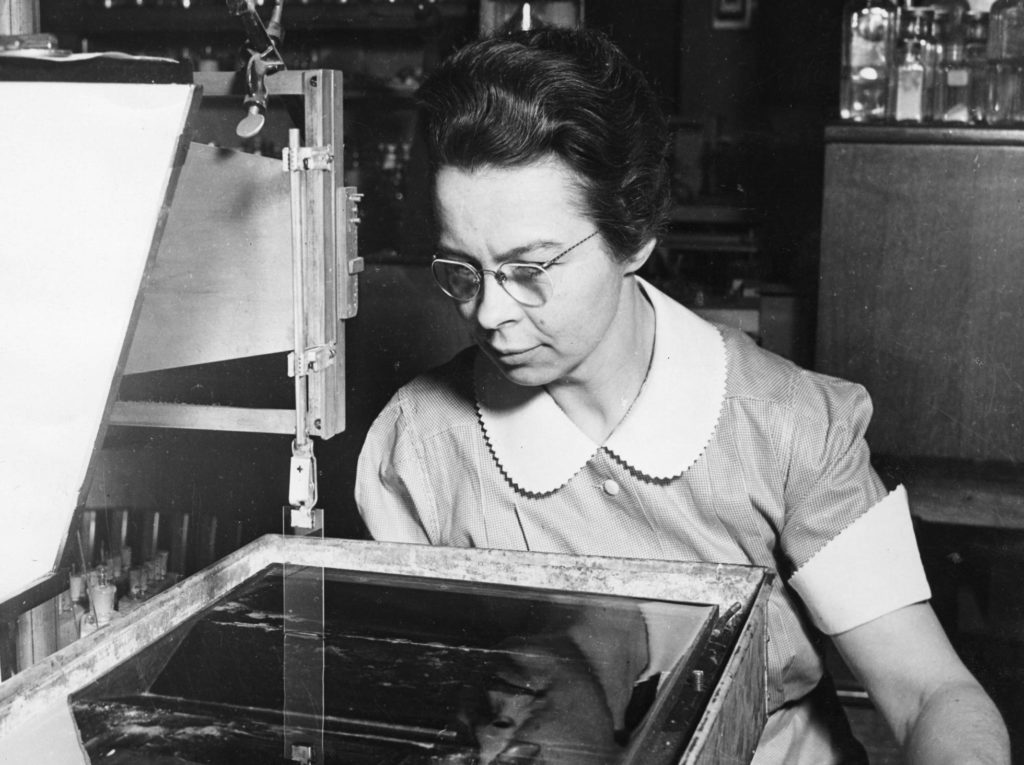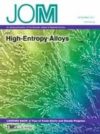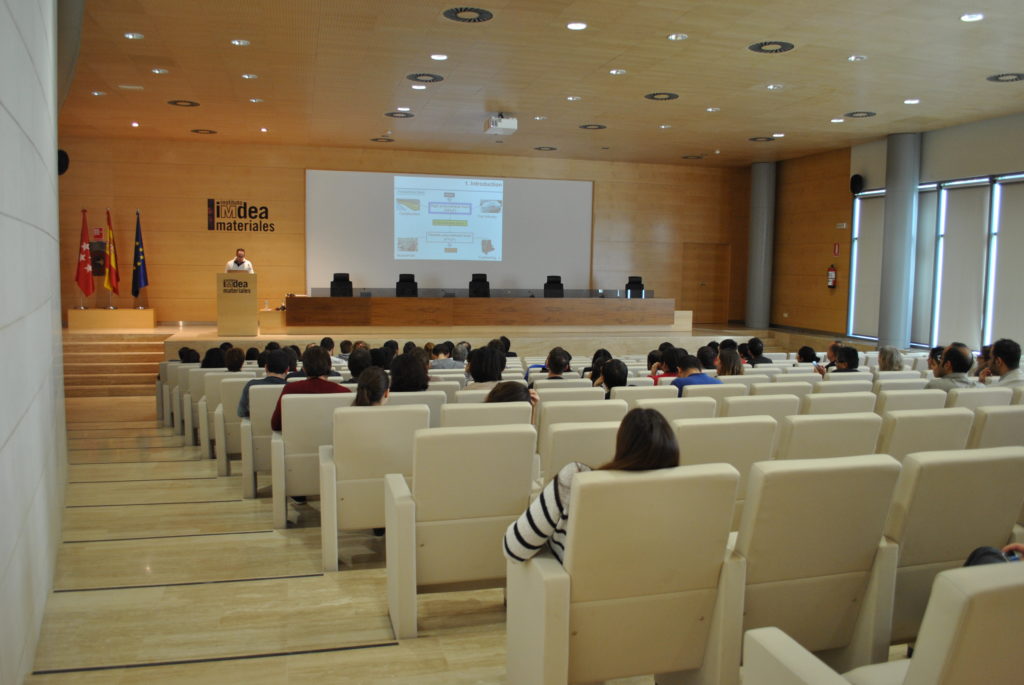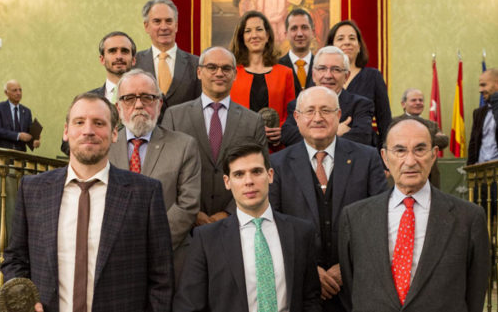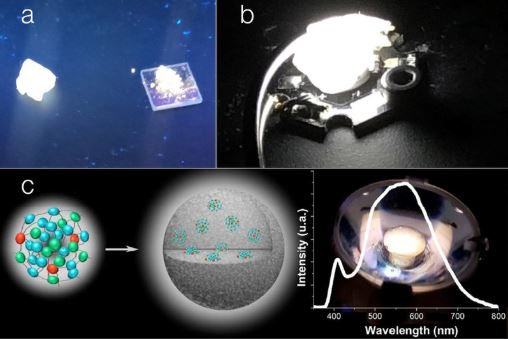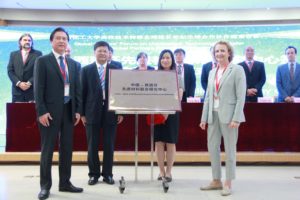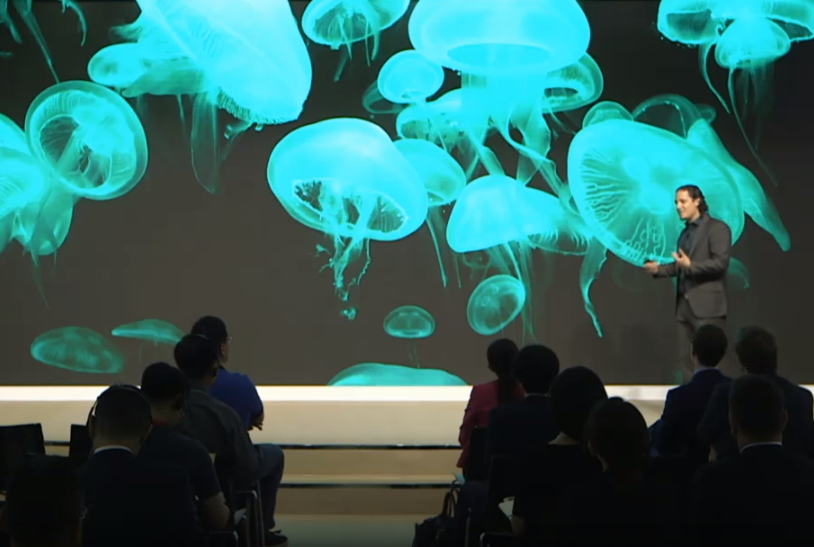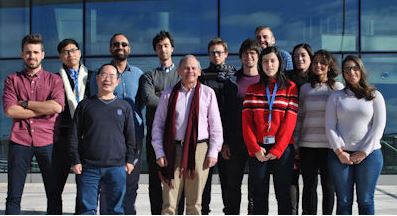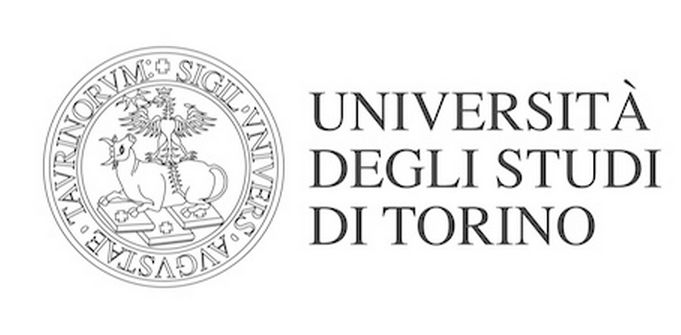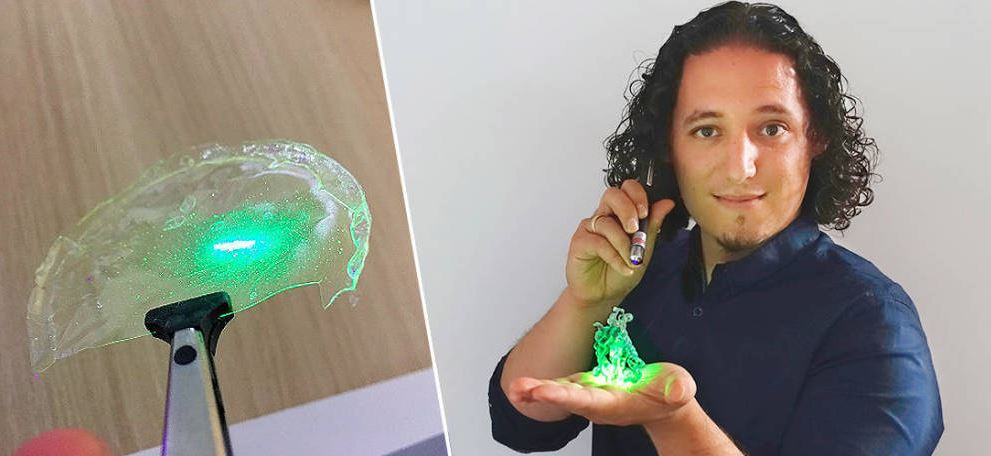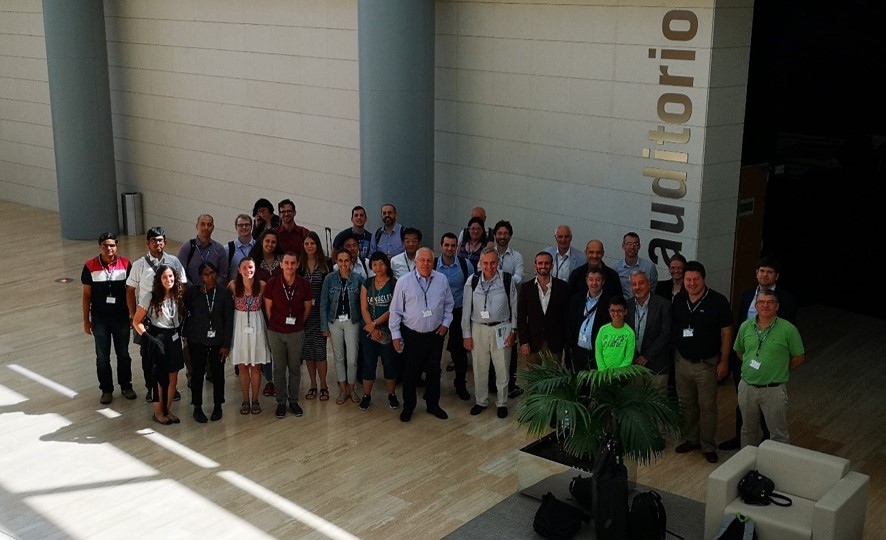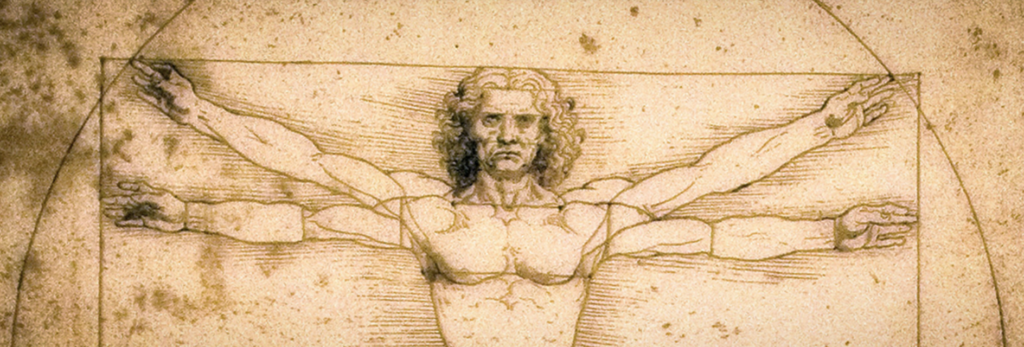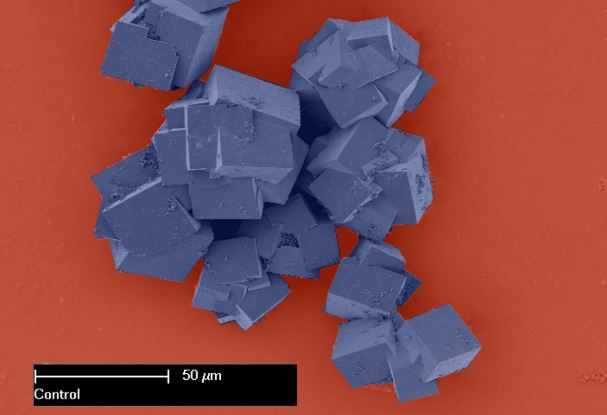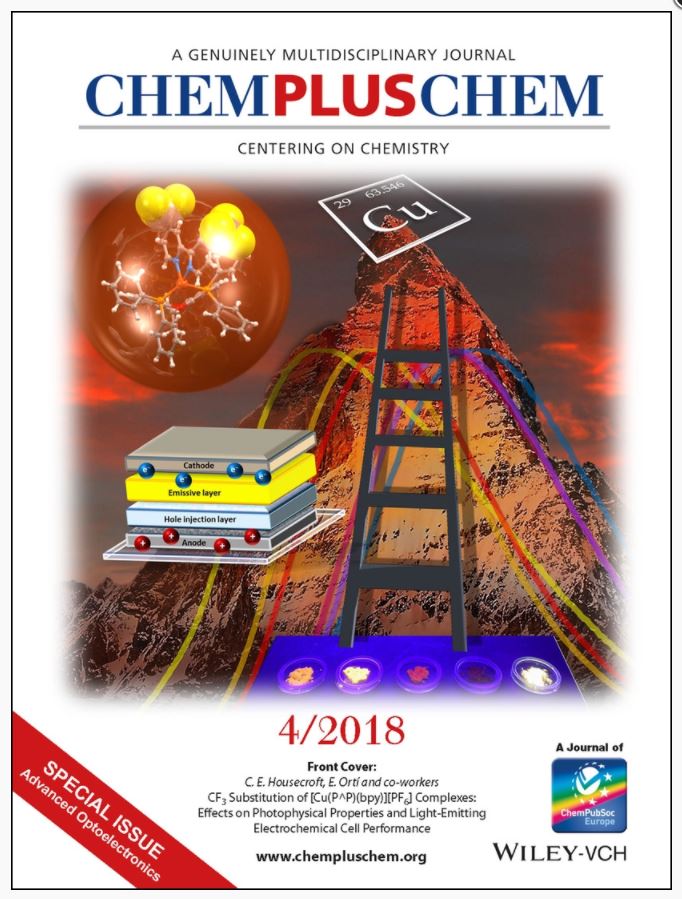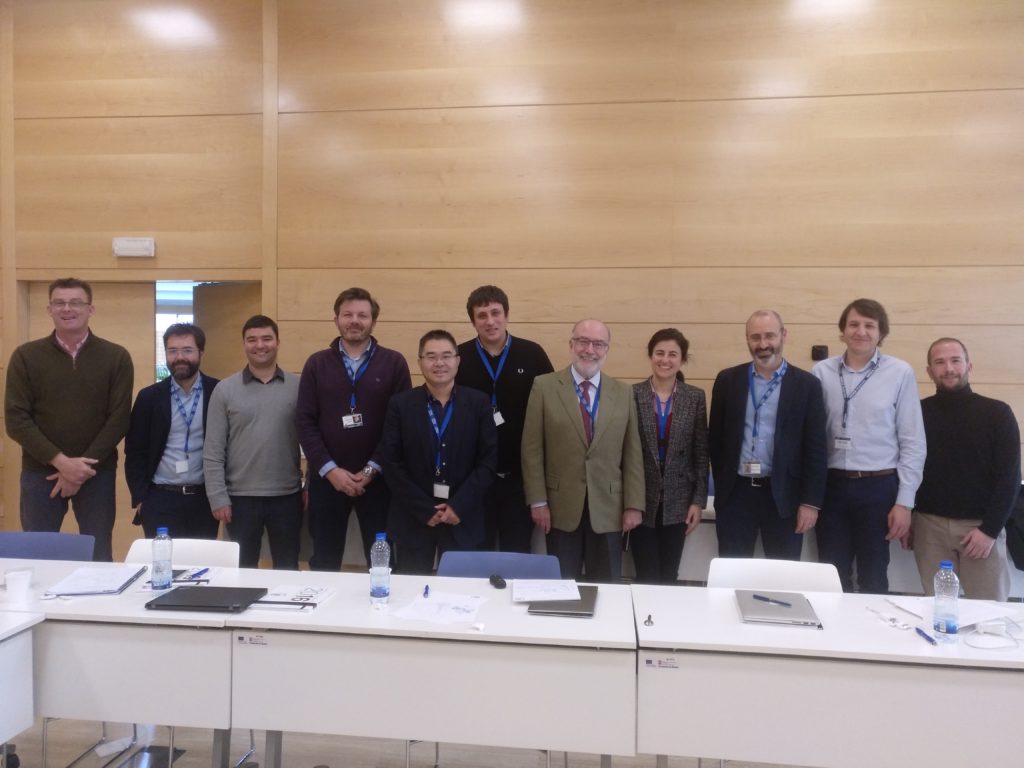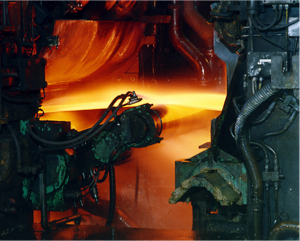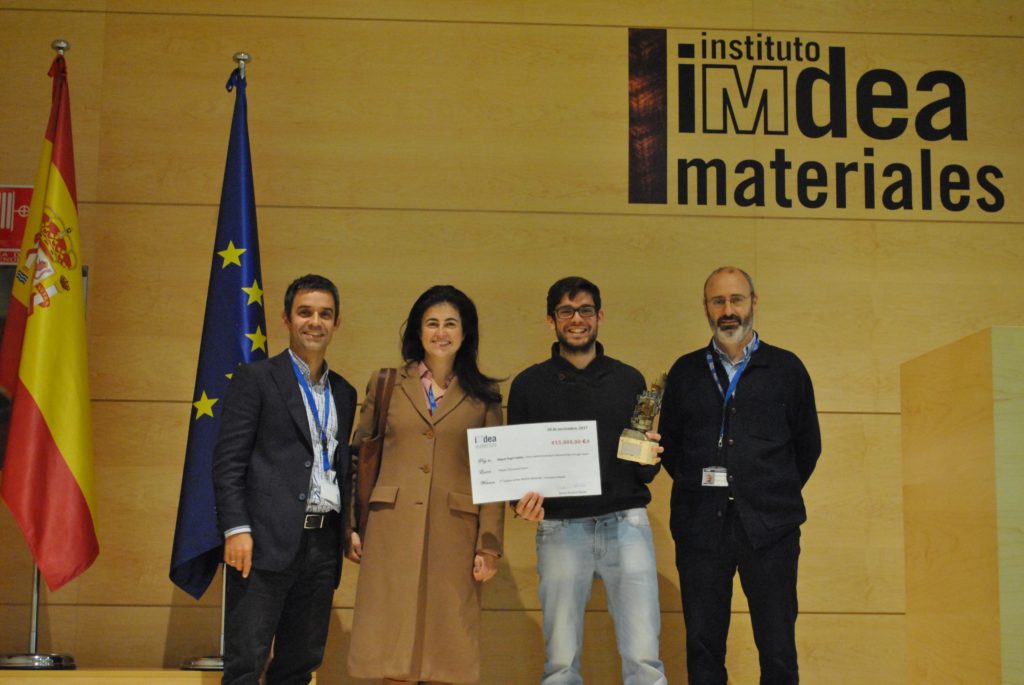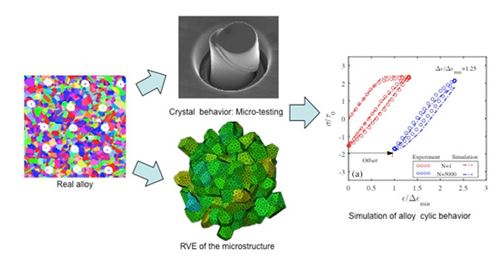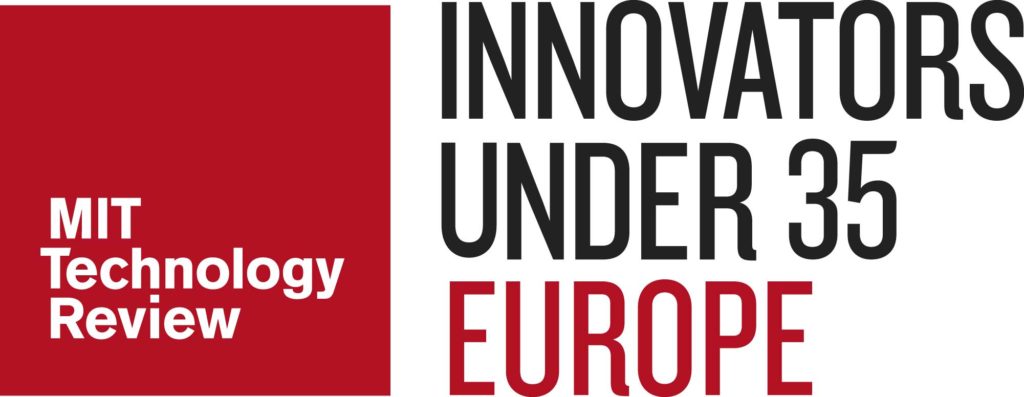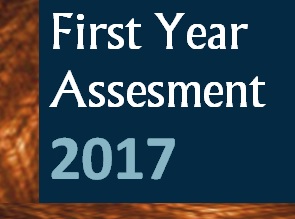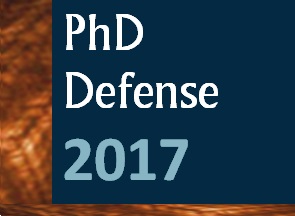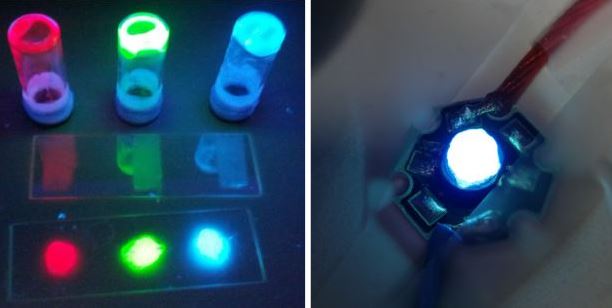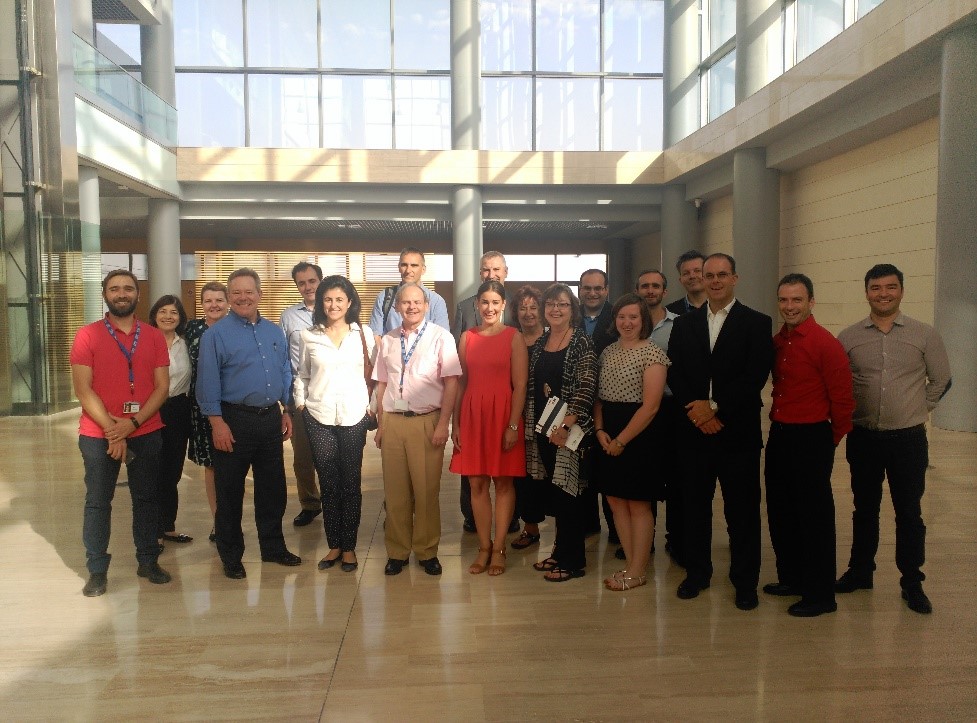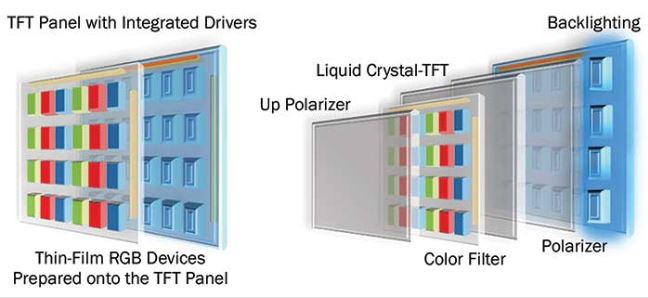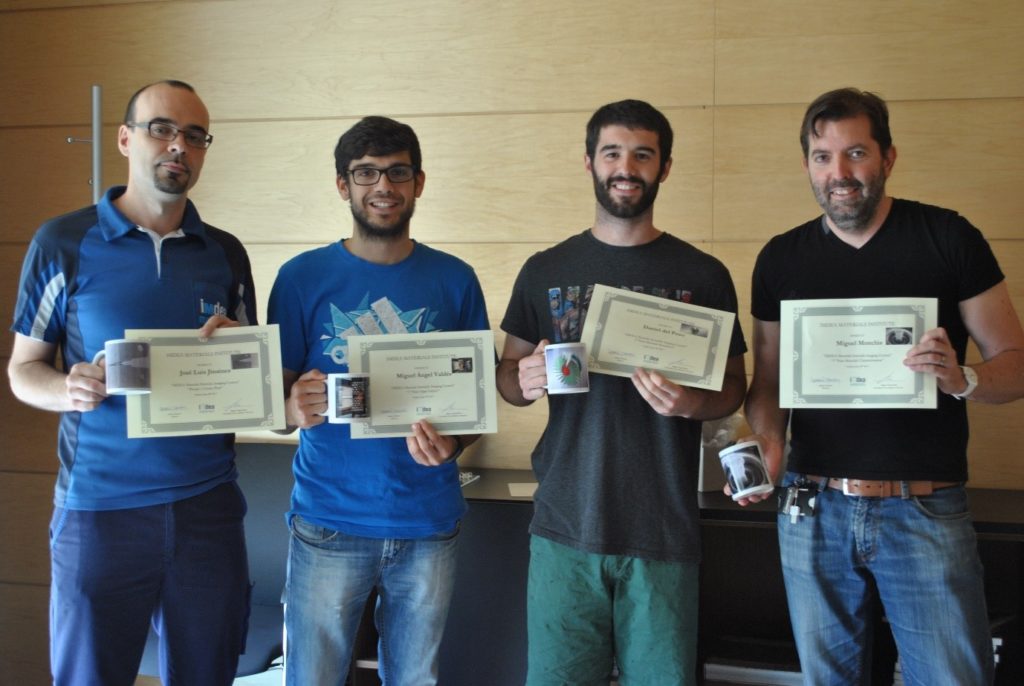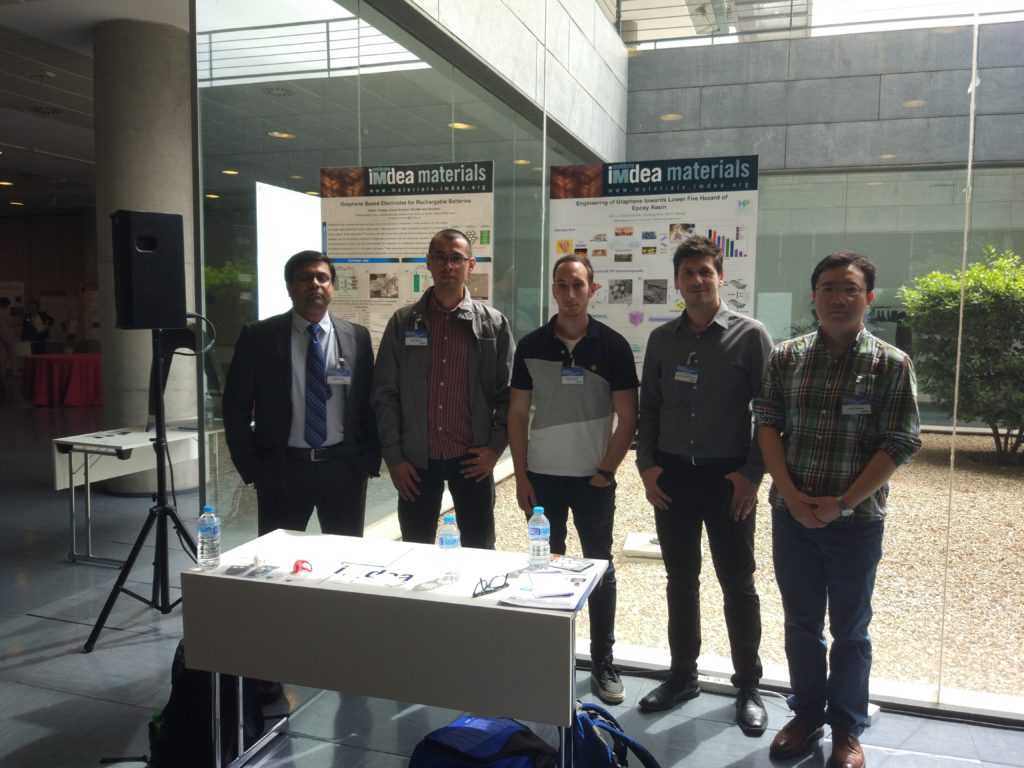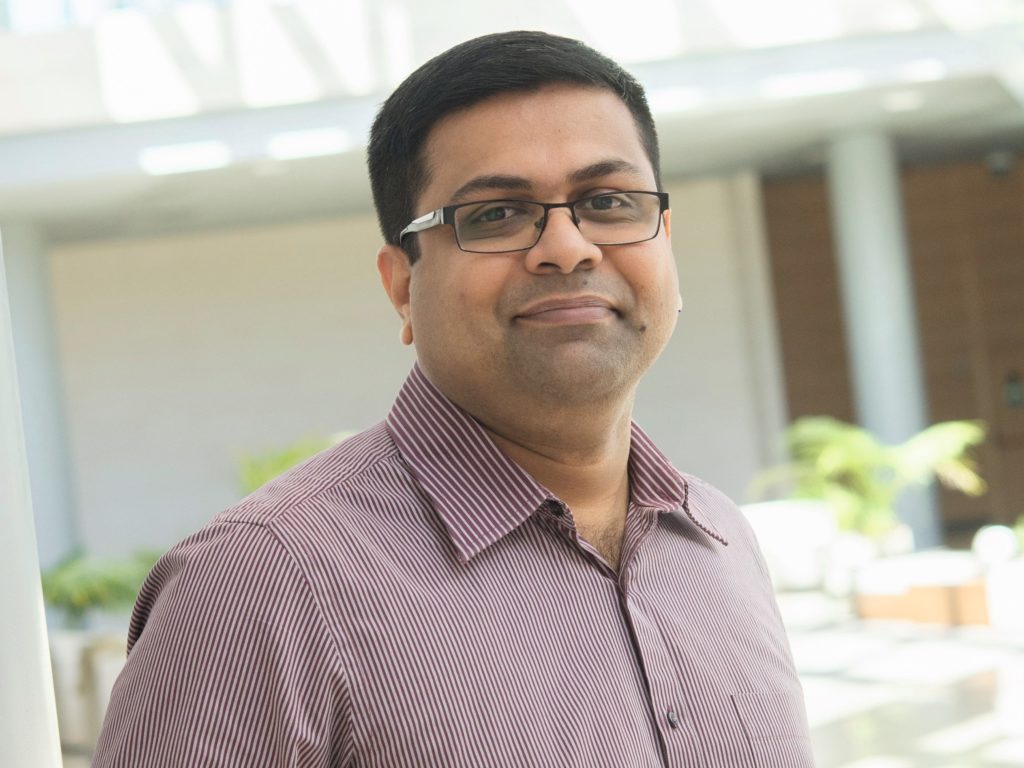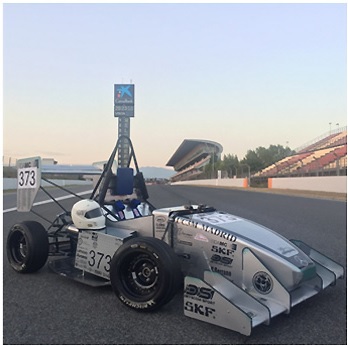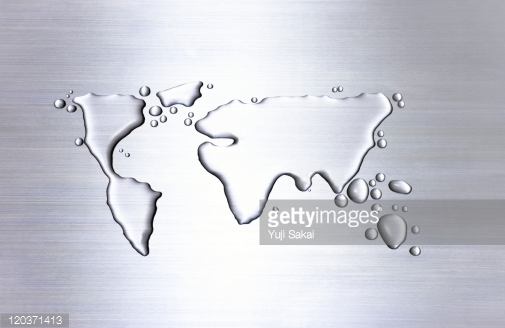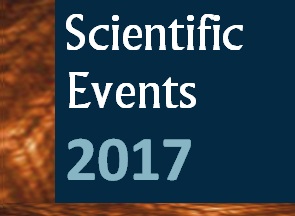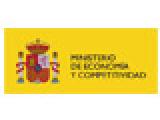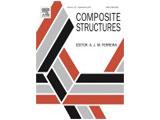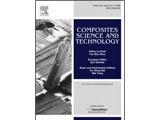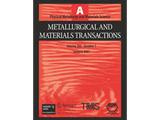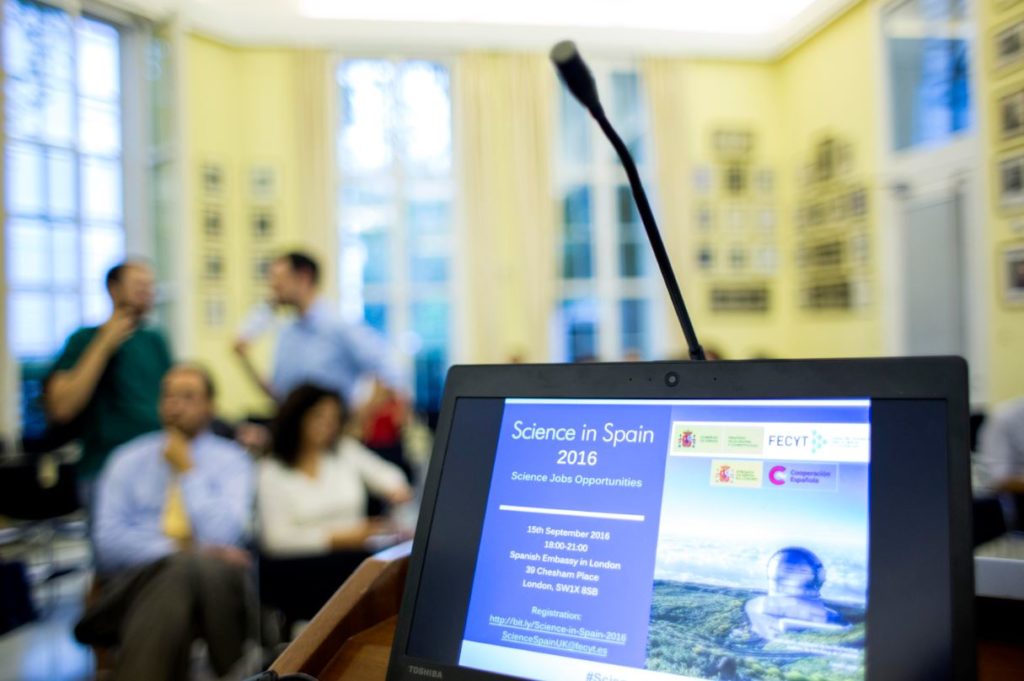Abstract: Grain boundaries (GB) are generally considered as static obstacles to dislocations and sinks for point defects and their clusters. But, in fact, the processes that take place at GBs is more complex and can reveal properties directly related to plasticity phenomena that go beyond the
Seminar of Prof. Eric Charkaluk (Directeur de Recherche CNRS – Laboratoire de Mécanique des Solides & Associate Professor at Ecole Polytechnique in France), entitle “Thermoplasticity through the scales” – At 12:00 pm, in the Seminar Room
ABSTRACT The Thermodynamics of Irreversible Processes (TPI) applied to the mechanics of materials boomed significantly in France in the 60s and 70s, under the impulse of Paul Germain. The formalization of the Generalized Standard Materials, proposed in 1975 by Bernard Halphen and Quoc-Son Nguyen,
Collaboration agreement with Waseda University
Our Institute has just signed a reseach collaboration agreement with Waseda University related to new material development for energy production and storage. This agreement will allow exchange of research staff between both institutions.
Seminar of Amaia Cipitria from Max Planck Institute of Colloids and Interfaces in Potsdam (Germany), entitle “Biomaterial physical properties in tissue regeneration” – At 12:00 pm, in the Seminar Room
Abstract: Cells respond not only to biochemical but also to physical cues, such as stiffness, geometry and matrix degradability. In-vitro studies showed that hydrogel elasticity or degradation properties alone can direct cell differentiation, while scaffold geometry can control tissue growth rate.
Seminar of Juan Pablo Fuenzalida from the University of Münster (Germany), entitle “Protein-based acoustic and photon spectroscopy: Applications from biomaterials to protein design” – At 12:00 pm, in the Seminar Room
Abstract: Evolution has provided us with the most abundant and versatile source of materials. In my talk, I will show how proteins can be used as labels and as building blocks. We will explore how an enzyme can be mutated and genetically conjugated to provide a tool for nanoparticle tracking and
PhD Defense of Marta Cartón entitle “Development and optimization of the properties of gamma/gamma´ co-based superalloys for high temperature applications”, under the supervision of Prof. José Manuel Torralba Castello and Prof. Mónica Campos Gomez.
The PhD Defense will take place, at 11:30, on next Thursday 21st of February, in Carlos III University (Leganes) in the classroom 7.01.H01. The dissertation is entitled “Development and optimization of the properties of gamma/gamma´ co-based superalloys for high temperature applications". Here is
20% success rate in call 2018 of Marie Skłodowska-Curie Actions Individual Fellowships
2 Marie Skłodowska-Curie Actions Individual Fellowships have recently been awarded to our Institute, and 2 more are on the reserve list. That represents a 20% success rate. Our new fellows will work in top-notch areas such as the numerical exploration of metallurgical alloys and inducing doping in
Andrea Fernández, winner of the award in environment of the “Young Talent Awards-Card Young”, given by Angel Garrido.
The president of the Community of Madrid, Angel Garrido, has participated in the ceremony of delivery of the "Talento Joven-Carné Joven", which recognized the trajectory of five young people between 14 and 30 years old who have highlighted in the last year in five categories: volunteering,
Women who design the future
In this opinion article in "El País" journal, our researcher Andrea García-Junceda claims the role of women in research centers, Universities and laboratories around the world. In order to achieve full and equal access to and participation in science for women and girls, and further achieve gender
Seminar of Joshua Kiefer from Delft University of Technology, in Holand, entitle “An example case for Machine-Learning in Materials Science: A neural networks based framework for ‘smart’ computational micromechanics of composites” – At 2:30 pm, in the Seminar Room
Abstract: We shall present a ‘smart’ framework, developed to create surrogate models of complex phenomena in an automated way, based on a minimum amount of computer simulations. To do so, the framework combines Design of Experiments, Computational Modeling, and Neural Networks. While such a
Seminar of Dr. Christian Leinenbach from EMPA (Swiss Federal Laboratories for Materials Science & Technology), in Zurich, entitle “Microstructure control during laser additive manufacturing – what possibilities do we have?” – At 15:30 pm, in the Seminar Room
Abstract: During the last couple years, laser-based additive manufacturing (AM) technologies such as laser powder bed fusion (LPBF) and directed energy deposition (DED) have evolved from a mere prototyping technology to a real production technology that allow building parts with intricate 3D
Seminar of Dr. Lorenzo Malerba, from CIEMAT, entitle “On the radiation-induced origin of hardening and embrittlement in nuclear steels” – At 12:30 pm, in the Seminar Room
Abstract: Predicting the changes in macroscopic properties of steels subjected to irradiation is key for the improved and long term safety of nuclear power plants. Because of the inherent complexity of the processes involved, this is a long-lasting challenge for nuclear materials science.
First Year Assessment of Qi Wang, entitle “Design and preparation of nanocarbon/epoxy nanocomposites with advanced flame retardancy and mechanical performance” – In the Seminar Room at 12:00 pm
Abstract: Efforts were paid to obtain nanocarbon/epoxy composites with advanced flame retardancy and mechanical performance, and try to understand the mechanisms. In the first part of the work, when 20 wt% ammonium polyphosphate (APP) in the chosen flame-retardant APP/epoxy composite was replaced
Seminar of Prof. Kostas Danas, from The Ecole Polytechnique (Paris), entitle “Microstructured Magnetorheological Elastomers and Instabilities” -At 12:00 pm in the Seminar Room
Absract: Magnetorheological elastomers (MREs) are ferromagnetic particle impregnated rubbers whose mechanical properties are altered by the application of external magnetic fields. In addition, these composite materials can deform at very large strains due to the presence of the soft polymeric
First Year Assessment of Richard Schaeufele, entitle “Synthesis and Characterisation of Inorganic Nanowires and their Assembly into Macroscopic Structures” – In the Seminar Room at 12:00 pm
Abstract: SiNWs, which are rod-like structures with diameters between 1-100nm and lengths of up to several tenths of micrometers, are an auspicious approach to enhance solar cells, thermoelectric devices and energy storage devices. Their extremely high aspect ratio (classifi ed as 1D material)
The work “Deformation Mechanism Map of Cu/Nb Nanoscale Metallic Multilayers as a Function of Temperature and Layer Thickness”, done by some of our researchers, has been elected as best paper in structural materials for year 2018 by JOM journal.
IMDEA Materials Institute has received a new award. This time, an article signed by some of its scientists has been chosen as the best published in the international JOM magazine. JOM magazine is the communication organ of the TMS, The Minerals, Metals & Materials Society, professional and
First Year Assessment of Abdumalik Yusuf, entitle “Study of the influence of phosphorus based flame retardants on the flammability, thermal and electrochemical properties of gel polymer electrolytes” – In the Seminar Room at 12:00 pm
Abstract Today, almost every portable device is powered by a lithium ion battery. Despite the wide use of lithium ion batteries, they suffer from serious safety issues. Gel polymer electrolytes (GPEs) are one of the most promising candidates to solve safety issues such as fire and liquid
PhD Defense of Juan Carlos Fernández, entitle “Microstructure-properties relations for hierarchically structured CNT fibres”, under the supervision of Prof. Juan José Vilatela
The PhD Defense will take place at 12 noon, on next Thursday (10th of January), in the Green Room of the Escuela de Caminos of the UPM. Here is the link of the school address in google
New grant from the European Research Council
Ruben Costa, head of the research group on Hybrid Optoelectronic Materials and Devices, has been awarded a Consolidator grant by the European Research Council. These grants allow ambitious top scientists to establish or strengthen their teams in Europe and be truly creative in their research. Ruben
First Year Assessment of Donfeng Shi , entitle “Influence of alloying additions on the deformation mechanisms of Mg-X binary alloys” – In the Seminar Room at 12:00 pm
Abstract Magnesium is an attractive metal for various technological applications due to its low density (23% of steel and 66% of aluminum) and availability. Applications of magnesium in the automotive and aerospace industries aim for weight reduction and enhanced fuel efficiency. However,
3rd edition of the IMDEA Materials´ Innovation Award
The 3rd edition of the IMDEA Materials´ Innovation Awards was held the 28th of November in the Auditorium of its facilities. Each of the 5 candidatures had the chance to give a 10 minutes presentation to explain/defend, in front of the evaluation panel and rest of IMDEA´s employees, why their
New bioresorbable materials for implant applications
Our Institute has started a new research line on novel bioresorbable materials for implant applications (see related news in Spanish). This work will be initially supported by the BIOIMPLANT project (funded by the European Union under the Marie Skłodowska-Curie Actions Innovative Training Networks).
The bests in China, also the bests in Spain
Dr. Xiaomin Zhao and Dr. Lingwei Yang have received the award to the best Doctoral Thesis at the Technical University of Madrid (UPM) in the academic year 2016-2017. The Doctoral Thesis of Dr. Zhao was defended in the Chemical Engineering Program and was co-supervised by Dr. D.-Y. Wang and Prof. J.
First Year Assessment of Mostafa Barzegar, entitle “Multiscale Computational Mechanics of Hybrid & Non-hybrid Composites” – In the Seminar Room at 11:00 pm
Abstract: This study aims to increase the understanding of the tensile failure of unidirectional hybrid and non-hybrid composite when subjected to tensile loadings. To achieve this goal several models with increasing complexity have been developed and implemented and the effects of tensile loading
PhD Defense of Daniel del Pozo entitle “Numerical Methods for the simulation of high velocity impact”, under the supervision of Prof. Ignacio Romero
The PhD Defense will take place, at 11:30 am, on next Thursday (22nd of November) in ETSI Industriales in aula D. The dissertation is entitled “Numerical Methods for the simulation of high velocity impact" Here is the link of the school address in google
First Year Assessment de Xaquín Rodiles titulado “Molecular and chirality control of CNTs synthesized via FCCVD process”– En la Sala de Seminarios a las 12:00 hr
ABSTRACT Carbon nanotubes (CNTs) have been a focus of nanomaterial research over the past two decades, due to their wide range of potential applications. In recent years, studies have shown a high degree of molecular control of CNTs in terms of number of layer, morphology and alignment, as well
First Year Assessment of Clara Galera, entitle “Additive manufacturing of high strength aluminum alloys with ZrH2 addition” – In the Seminar Room at 12:00 pm
Abstract Additive manufacturing (AM) is a layer by layer process that has the potential to disrupt traditional fabrication methods. It allows fast manufacturing of three dimensional pieces from metallic powders, with great exibility of design, potential for weight reduction, fast production speed
IMDEA Materials on tv: Bioculture applied to lightning technologies
Rubén Costa explains his research line related to biological lightning in the national tv news (in Spanish only)
Juan José Vilatela awarded best researcher under 40 by the Madrid regional government
Juan José Vilatela, head of the Multifunctional Nanocomposites group at IMDEA Materials, has been awarded best researcher under 40 by the Madrid regional government. The award giving ceremony will take place next november 14th in Madrid (Spain).
First Year Assessment of Alejandro Rodríguez, entitle “Analysis of the nucleation and growth mechanisms of fatigue cracks in Ni-based superalloys” – In the Seminar Room at 4:30 pm
Abstract: Ni-based superalloys play an extremely important role in the aerospace industry due to their outstanding strength and chemical stability at high temperature. Most demanded components employed in jet engines are manufactured with these novel materials. Several statistical studies confirm
First Year Assessment of Cristina Gutierrez, entitle “Third generation γ-TiAl alloys for greener turbines: heat treatment and microstructure characterization” – In the Seminar Room at 12:00 pm
ABSTRACT The previous design of engines used for commercial aircrafts fan and turbine were driven with same shaft; new geared engines decouple fan and the low pressure turbine increasing angular velocity, and also centrifugal forces, so a change from conventional superalloy blades to lighter ones
First Year Assessment of Carmen Fernández, entitle “Rigid fluorescent protein coatings for highly efficient and stable bio-hybrid LEDs” – In the Seminar Room at 12:00 pm
Abstract Additive manufacturing (AM) is a layer by layer process that has the potential to disrupt traditional fabrication methods. It allows fast manufacturing of three dimensional pieces from metallic powders, with great exibility of design, potential for weight reduction, fast production speed
We are working in a paradigm swift related to lightning technologies
Rubén Costa is working in a paradigm swift related to lightning technologies, based in biological LEDs. Read more about his research line on solar windows in this article published by "El Mundo" journal (in Spanish only).
PhD Defense of Alfonso Monreal entitle ”Energy Harvesting Materials Based on Carbon Nanotube Fibre for Tough Electronics”, under the supervision of Dr. Juan José Vilatela
The PhD Defense will take place, at 12 noon, on next Friday (26th of October) in the “sala verde”, on the first floor, in the Escuela de Ingenieros de Caminos, UPM (ETSI Caminos, Ciudad Universitaria) The dissertation is entitled “Energy Harvesting Materials Based on Carbon Nanotube Fibre for
Seminar of Prof. Oana Cazacu, from the University of Florida, entitle “New models for description of plastic anisotropy of single crystals and polycrystals” – At 12:00 pm in the Seminar Room
Abstract: It is presented a rigorous framework developed for formulation of constitutive models. Based on representation theory for tensor functions and scale-bridging theorems, this framework enables the development of constitutive models that account for the influence of crystallographic
A material similar to sand that emits high quality white light for a new generation of LEDs hybrid
The high content of blue light presented by current LEDs can be harmful to the human retina, especially for children, and has a negative impact on our brain´s chemistry. Rubén Costa, researcher at the IMDEA Materials Institute of Madrid; Elena Lalinde and Jesús Berenguer, from the University of La
Madrid hosts the 55th annual technical meeting of the Society of Engineering Science (SES), the first time outside the US
We are hosting the 55th edition of the Annual Technical Meeting of the Society of Engineering Science (SES). The SES Technical Meeting is held annually to provide an interdisciplinary forum for the exchange of ideas and information among the various disciplines of engineering and the physical and
Seminar of Prof. Jesus Barrio, from the Ben-Gurion University (Israel), entitle “Rational Design of Carbon Nitride Materials by Supramolecular Preorganization of Monomers” – At 11:00 am in the Seminar Room
Abstract Over the past few years, graphitic carbon nitride (g-CN) has attracted widespread attention due to its outstanding electronic properties, which have been exploited in various applications, including in photo- and electro-catalysis, heterogeneous catalysis, CO2 reduction, water splitting,
Seminar of Prof. Irene J. Beyerlein, from the University of California at Santa Barbara, entitle “Discrete slip crystal plasticity modeling of deformation in nanolayered materials” – At 12:30 pm in the Seminar Room
Discrete slip crystal plasticity modeling of deformation in nanolayered materials Irene J. Beyerlein1, Tianju Chen2, Rui Yuan2, Caizhi Zhou2,3 1 Mechanical Engineering Department, Materials Department, University of California at Santa Barbara, Santa Barbara 93106, USA 2 Department of Materials
First Year Assessment of Venkata Sai, entitle “Nanoscale engineered electrode materials for high performance Lithium-ion batteries” – In the Seminar Room at 12:00 pm
Abstract Herein, highly ordered mesoporous pseudocapacitive electrodes for superior Li-ion storage are discussed. Hierarchical 1-D Co3O4nanorods of size ~20 nm with interfaces between the crystallites were synthesized using hydrothermal method followed by calcination. This 1D nanorods exhibited
Sino-Spanish Joint Research Center of Advanced Materials
On 15th September 2018, nine units from China and Spain (Beijing University of Chemical Technology, Beihang University, The Going Global Confederation of China Petroleum & Chemical Industry from China, the Technical University of Madrid, IMDEA Materials Institute, the Department of Innovation,
First Year Assessment of Clara Galera, entitle “AAdditive manufacturing of high strength aluminum alloys with ZrH2 addition” – In the Seminar Room at 12:00 pm
Abstract Additive manufacturing (AM) is a layer by layer process that has the potential to disrupt traditional fabrication methods. It allows fast manufacturing of three dimensional pieces from metallic powders, with great exibility of design, potential for weight reduction, fast production speed
IMDEA Crime Scene Investigation
Researchers belonging to all IMDEA institutes solved a new crime in the activity "IMDEA-CSI" as part of the European Researchers' Night Madrid 2018. More information about the event in this podcast (radio show "Por tres razones", RTVE)
Seminar of Dr. Laszlo Sturz from the Access e.V. Intzestr. (Germany), entitle “Microgravity experiments on solidification” – At 3:00 pm in the Seminar Room
Abstract: Solidification is one of the major steps in producing parts from the molten material in casting, welding or additive manufacturing. On top of process optimization and simulation to obtain good mould filling and minimized defects, the quality of the cast parts depends strongly on the
First Year Assessment de Wenliang Feng, titulado “Na-ion Hybrid Energy Storage Devices Based on Nanoengineered Electrodes” – En la Sala de Seminarios a las 12:00 am
Abstract In this study, dimension control and nanostructure design were applied in developing electrode materials for superior Na-ion storage. Firstly, hierarchical Co3O4nanorods with increased number of interfaces between individual nanocrystallites were prepared for enhancing pseudocapacitance
First Year Assessment of Maria Azzurra, entitle “Intermediate strain rate testing methodologies for composite materials characterisation” – In the Seminar Room at 12:00 am
ABSTRACT: The main objective of this work is to create a physical platform for material characterization and parameter identification at macroscale as a function of applied strain rate, understanding how the strain rate affects the damage and mechanical response of three different composite material
Ruben costa, the sole spanish researcher selected to participate in the World Economic Forum meeting in Tianjin
Rubén Costa, senior researcher at IMDEA Materials, has been recognized as one of the best scientists in the world under the age of 40 by the World Economic Forum, where his work on sustainable materials often intersects with broader discussions on global innovation and regulatory frameworks. He
Passion to face new challenges and cross new borders is a clear sign of virtue and vocation in science
Our Scientific Director and head of the Mechanics of Materials research group, Prof Javier Llorca, explains his vision of the researcher's career in this interview (in Spanish only)
PhD Defense of Evgeny Senokos entitle ”Development of Multifunctional Flexible and Structural Supercapacitors Based on CNT Fibers”
The PhD Defense will take place, at 12 noon, on next Friday (7th of September) in the “sala verde”, on the first floor, in the Escuela de Ingenieros de Caminos, UPM (ETSI Caminos, Ciudad Universitaria) The dissertation is entitled “Development of Multifunctional Flexible and Structural
Seminar of Prof. Piaras Kelly, from the University of Auckland (NZ), entitle “Advanced Composite Materials: manufacturing quality products efficiently” – At 12:00 pm in the Seminar Room
Abstract: Advanced composite materials are now used in a wide range of industries, including aerospace, marine, construction, transport and recreational sport. The ever-increasing pressure on producing quality parts effectively and efficiently has led to many innovations over the years in
Research Assistant Elisa Fresta awarded with best Master Thesis Prize
Research Assistant Elisa Fresta has been awarded a Prize for one of the best Master Thesis (year 2015/2016) from the University of Turin. The thesis was developed at both the University of Turin and the University of Erlangen-Nuremberg under the supervision of Prof. Claudia Barolo and Dr. Rubén
We will develop the first solar window made of organic materials thanks to the BBVA Foundation
Rubén Costa and his team (below) will develop the first solar window made of organic materials thanks to a grant awarded by the BBVA Foundation. You can read here a related article published by "El Confidencial" journal (Spanish)
New nanostructured material for capacitive deionization
Researchers from our institute have developed in collaboration with IMDEA Energy a new current collector-free capacitive deionization architecture based on electrodes consisting of a porous metal oxide network interpenetrated into porous fibres of carbon nanotube. The full device has a large salt
First Year Assessment of Mario Rueda entitle “Nanoindentation impact testing methodologies for the high strain rate characterization of materials at the microscale” – In the Seminar Room at 09:30 am
Abstract: In view of the future application of polymer matrix composites for structural components subjected to impact loads, there is a need for development of experimentally calibrated constitutive models for polymers that include their inherent viscoelastic and viscoplastic behavior. These
Last June, IMDEA Materials hosted the First International Workshop on Multi-functional Nanocarbon Fibres
Last June, IMDEA Materials hosted the First International Workshop on Multi-functional Nanocarbon Fibres. The meeting gathered leading international researchers working on nanocarbons developing the next generation of functional carbon fibres and fabrics based on nanobuilding blocks. There were
PhD Defense – Zhi Li ”Ignition Delaying and Smoke Suppression Study of Fire-Retardant Polymer Composites”, under the supervision of Dr. De-Yi Wang
Time, Place, PhD thesis Title The Ph.D work is entitled as “Ignition Delaying and Smoke Suppression Study of Fire-Retardant Polymer Composites” under the supervision of Dr. De-Yi Wang. This event will be taking place at 12:00am (16th, July) in “Seminar Room” of ETS de Ingenieros de Caminos, Canales
Seminar of Dr. Lukas Helfen, from Karlsruhe Institute of Technology, entitle “Synchrotron Laminography: A Technique for In situ Observation of Damage and its Evolution Inside Engineering Materials ” – At 1:00 pm in the Seminar Room
Synchrotron Laminography: A Technique for In situObservation of Damage and its Evolution Inside Engineering Materials Lukas Helfen,1,2Mark N. Mavrogordato,3Thilo F. Morgeneyer,4T. Baumbach1 1 Institute for Photon Science and Synchrotron Radiation, Karlsruhe Institute of Technology, PO Box 3640,
Seminar of Dr. Mariana Hamer, from the University of Buenos Aires (UBA), entitle “Porphyrin-based nanomaterials: design, synthesis and applications” – At 11:30 am in the Seminar Room
Porphyrin-based nanomaterials: design, synthesis and applications Abstract The development of new nanomaterials and nanotechnology currently have a huge impact on modern science. Within this trend, a field that has taken relevance is the construction of nanometric supramolecular systems through
PhD Defense – Miguel Herraez “Computational Micromechanics Models for Damage and Fracture of Fiber-Reinforced Polymers”, under the supervision of Prof. Carlos González and Dr. Cláudio Lopes.
The PhD Defense will take place, at 12 noon, on next Friday (13th, July) in the seminar room of the Department of Materials Science at the School of Civil Engineering of UPM (ETSI Caminos, Ciudad Universitaria). The dissertation is entitled "Computational Micromechanics Models for Damage and
First Year Assessment of Verónica Fernández – Luna, entitle “Towards the understanding of FP-coating stability in Bio-LEDs” – In the Seminar Room at 12:00 pm
ABSTRACT Solid-state lighting (SSL) is one of the biggest achievements of the 20th century. It has completely changed our modern life with respect to general illumination (light-emitting diodes), flat devices and displays (organic light-emitting diodes), and small labelling systems (light-emitting
Prof. Javier Llorca awarded by SOCIEMAT
Prof. Javier Llorca, Scientific Director of IMDEA Materials Institute, has received the award to the best scientific career by SOCIEMAT Javier Llorca receiving the SOCIEMAT award to the best scientific career during the CNMAT 2018 conference
PhD Defense – Mohammad Marvi-Mashhadi “Multiscale Characterization and Modelling of Polyurethane Foams”, supervised by Dr. Claudio Lopes and Prof. Dr. Javier LLorca.
The PhD Defense will take place on next Wednesday (11th, July), at 12 noon, at the "Seminar room" in the ‘’ Departamento de ciencia de Materiales, E.T.S.I. Caminos(Campus de Ciudad Universitaria,
Seminar of Dr. Vilas G. Pol, from Purdue University, entitle “Engineered Electrodes for Efficient Energy Storage and Battery Safety” – At 12:00 pm in the Seminar Room
Abstract ViPER (Vilas Pol’s Energy Research) laboratory at Purdue University focuses their research activities on the development of high capacity electrode materials, their engineering for longer cycle life and improved safety. Considering the advantages and limitations of known synthesis
Rubén Costa, awarded one of the 2018 Leonardo Grants to Researchers and Cultural Creators
Dr. Rubén Costa has been awarded one of the 2018 Leonardo Grants to Researchers and Cultural Creators by the BBVA Foundation. Leonardo Grants are intended to directly support personnal projects of researchers and cultural creators in intermediate stages of their professional careers, between 30 and
First Year Assessment of Ismael Gómez entitle “”Algorithms and tools for detection and characterization of molecular porosity and applications thereof”” – In the Seminar Room at 12:00 pm
IMDEA Materials will host the First International Workshop on Multi-functional Nanocarbon Fibres
The First International Workshop on Multi-functional Nanocarbon Fibres, which will take place at the IMDEA Materials Institute between 27-29 June, 2018, will gather leading researchers around the globe working on nanocarbons, with a view to developing the next generation of functional carbon fibres
Clean Sky 2 visit
Past tuesday 5th of June, representatives of the Clean Sky 2 visit our Institute as part of the Engine Integrated Technology Demonstrator (ITD) annual meeting, organized by ITP Aero. Our Instutute is currently participating in 3 Clean Sky 2 projects: REDISH, (CROR Engine Debris Impact SHielding.
Seminar of Carlos M. Atienza, from the Biomechanics Institute of Valencia, entitle “3D printing technologies, new possibilities for customized products and services for TOC” – At 12:00 pm in the Seminar Room
3D printing technologies, new possibilities for customized products and services for TOC There will be first an introduction to the activities of the IBV (Valencia Biomechanics Institute), to then explain the biomechanical bases of additive manufacturing through EBV that led the IBV to work on this
Summer School & Industry Day: Additive Manufacturing
On July 23rd and 24th IMDEA Materials Institute organizes a Summer School on Additive Manufacturing and an Industry Day where prominent companies (Siemens, ITP, Renishaw, HP, LPW Technologies, Mizar Additive) will discuss the progress of the field as well as the challenges ahead. This event is
First Year Assessment of André Rittner Pires Correa entitle “A numerical approach on thermoforming simulation of UD prepregs” – In the Seminar Room at 12:00 pm
Abstract Composite materials are a serious competitor for lightweight metals used in the aerospace and automotive industry. Fast production methods like thermo-folding, diaphragm forming or stamping can produce large numbers of CFRP components in a cost efficient way. The weight saving benefits of
Success in call 2018 of Marie Skłodowska-Curie Actions Innovative Training Networks
One Marie Skłodowska-Curie Action Innovative Training Networks (ITN) has recently been awarded to our Institute, representing a 17% success rate. This new project (BioImplant ITN) will train 12 young researchers in the area of development of bioresorbable materials for orthopaedic and vascular
MINIMAL project
MINIMAL is a research endeavour which will contribute significantly towards improving analysis/predictive tools for dislocation-interface interactions in metallic nanolaminates, which have attracted application as mechanical parts in Micro Electro Mechanical Systems (MEMS). It is funded by the
Seminar of Dr. Indrat Aria, from Cranfield University, entitle “Synergistic CVD graphene and ALD alumina for permeation barrier applications” – At 1:00 pm in the Seminar Room
Abstract Permeation barrier films are critical to a wide range of applications ranging from food and medical packaging to organic electronics and photovoltaics. For some of these applications, not only low permeation values are required but also flexible and transparent. Here, I will present
Seminar of Dr. Eric Jägle, from the Max Planck Institute of Metals Research in Düsseldorf (Germany), entitle “Alloys for Additive Manufacturing, Alloys by Additive Manufacturing” – At 11:00 am in the Seminar Room
Abstract As Additive Manufacturing technologies are being adopted in more and more industries, the focus of research and development is shifting to the materials in use. On the one hand, limited processability of high-performance materials restrict the robustness of the process in some cases, while
Annual report 2017 is out
The outcome of the research activities performed during year 2017 is summarized in this document. Information about the centre Principal Investigators, current research projects, research infrastructures as well as dissemination activities can be found in this annual report, together with scientific
Jon Molina awarded best young researcher by UC3M
Dr. Jon Molina has been awarded as one of the best young researchers by Carlos III University of Madrid (UC3M). The full information of this award can be found in this link (in Spanish only)
Large surface area lends superpowers to ultra-porous materials
Some materials are special not for what they contain, but for what they don’t contain. Such is the case with metal-organic frameworks (MOFs) – ultra-porous structures that are being developed for a variety of future applications from fire-proofing to drug-delivery. Read the whole article in HORIZON
Seminar of Prof. Marisol – Martín González, from the Instituto de Micro y Nanotecnología, entitle “Nanoengineering thermoelectrics to improve their efficiency: some examples” – At 12:00 am in the Seminar Room
Short summary of her group Functional Nanoscale Devices for Energy Recovery Group (FINDER) (Instituto de Micro y Nanotecnología) Their research is focused on the optimization of thermoelectric devices via nanostructuration. A thermoelectric device is able to transform temperature differences into
Optoelectronics special issue
A special issue organized by our colleague Rubén Costa on new materials and approaches for optoelectronics is free to read in ChemPlusChem through May! Check it out under this link: https://onlinelibrary.wiley.com/toc/21926506/83/4
Seminar of Dr. Thomas Bieler, from the department of Physical Metallurgy, Grain Boundaries, Crystal Plasticity from IMDEA Materials, entitle “The challenge of finding critical resolved shear stress values for meso-scale modeling of titanium alloys” – At 12:00 am in the Seminar Room
Short bio: Professor Thomas R. Bieler earned a B.A. in Applied Mechanics at University of California at San Diego in 1978 followed by a M.S. In Ceramic Engineering at University of Washington (Seattle) in 1980. He worked for five years at Sandia National Laboratory in Livermore on high rate
IMDEA Materials Institute opens its doors to the future of scientific research in “4ºESO+Empresa”
Last week we participated in the program "4ºESO + empresa", through which high school students of the Lourdes School made an approach to an adult work environment and thus better understand the world of work.
7th Edition of the IMDEA Materials Imaging Contest
On March1 16th, the Director and Deputy Director of the Institute gave the awards to the winners of the 2017 edition of the IMDEA Materials Imaging Contest.
CIMNE – IMDEA Materials Workshop
On April 13, a bilateral technical meeting was held between the International Centre for Numerical Methods in Engineering (CIMNE) and the IMDEA Materials Institute. Twelve researchers from both institutions attended the workshop, which took place at IMDEA Materials’ facilities in Tecnogetafe, with
VIII Conference with Science in the School – Circulo de Bellas Artes
On March 6 and 7 we will participate in the VIII Conference with Science in the School, organized by Circulo de Bellas Artes and FUHUMER. Our colleagues Juan Pedro Fernandez, Maria Azurra, Jose Sanchez and Jaime Castro will do their best to bring science closer to citizens!
Seminar of Prof. Efstathios I. Melts, from the Department of Materials Science and Engineering of the University of Texas at Arlington, entitle “The Quest for New Materials: Interface-engineered Materials” – At 12:00 am in the Seminar Room
ABSTRACT Atomic interface structures provide a unique opportunity to design new materials that can provide promising solutions to future technological demands. This talk presents an overview of two diverse areas of activity at the Surface and Nano Engineering Laboratory at the University of Texas,
Energy storage in structural composites by introducing CNT fiber/polymer electrolyte interleaves
The paper entitled "Energy storage in structural composites by introducing CNT fiber/polymer electrolyte interleaves" is available for download at Scientific Reports journal. This is a recent work by the multifunctional nanocomposites group, headed by Dr. Juan José Vilatela. This work presents a
Nearly 30% success rate in call 2017 of Marie Skłodowska-Curie Actions Individual Fellowships
3 Marie Skłodowska-Curie Actions Individual Fellowships have recently been awarded to our Institute, and 2 more are on the reserve list. That represents nearly a 30% success rate. Our new fellows will work in top-notch areas such as nanostructured yarn composites for structural energy storage, new
International Women and Children in Science Day at IMDEA Materials Institute
Last Tuesday, February 8, IMDEA Materials opened the doors to children of the Community of Madrid to have the opportunity to know the great work done by women scientists and transmit them the enthusiasm they have in science. In the following link you can see a brief explanation of the activities
Seminar of Prof. Jiacheng Wang, from the Shanghai Institute of Ceramics, Chinese Academy of Sciences (CAS), entitle “Emerging Materials for Electrocatalysis” – At 11:30 am in the Seminar Room
Abstract Platinum-based materials are highly active as the electrocatalysts both in hydrogen evolution reaction (HER) and oxygen reduction reaction (ORR) in fuel cells, but high cost limits its wide applications. In this talk, the reporter summarized the recent research progress of designing and
Is ultra-fast processing the next revolution for steel production?
Researchers of our Institute collaborate with an international consortia to develop an ultra-fast processing process for steels. This approach is energetically more efficient than current methods. You can learn more about this technique in this article (Spanish only)
PhD Defense – Yetan Pan “Synthesis of nano-flame retardant and its use as a promising substitute of antimony trioxide in flame retardant flexible poly(vinyl chloride)”, supervised by Dr. De-Yi Wang.
The PhD Defense will take place on next Tuesday (23rd, January), at 12 noon, in the Sala Verde (first floor) in the Escuela de Ingenieros de Caminos, UPM The link below shows the address of the
New project supported by the Center for Nanoscale Materials at Argonne National Laboratory
The Center for Nanoscale Materials at Argonne National Laboratory will support the research project entitled "Atomistic simulations of precipitate-strengthening for optimum design of light alloys for green transport", who will be carried out by Prof. J. LLorca, Dr. I. Papadimitrou and Mr. Gustavo
First Year Assessment of Can Fu entitle “Design and study of multifunctional flame retardant polyester fabric” – In the Seminar Room at 12:00 pm
ABSTRACT Poly(ethylene terephthalate) (PET) is extensively used in the production of fibers and films and now increasingly used as container material for soft drink due to its outstanding characteristics of high strength, good flexibility, and thermal stability, but their uses are limited by their
2nd IMDEA Materials Innovation Awards
On 28th of November took place the 2nd IMDEA Materials Innovation Award. The Director of the Institute, Prof. Ignacio Romero, gave the award to Miguel Angel Valdes on his winner project entitle ““Ultra-rapid processing of advanced high strength steels”. The 2nd edition started with the last year´s
First Year Assessment of Jing Zhang entitle “Metal organic frameworks (MOFs) derived hierarchically nanomaterials as multifunctional fire retardant for polymer nanocomposites” – In the Seminar Room at 12:00 pm
Abstract Fire hazards including the generation of heat, smoke and toxic vapor, cost a great number of lives and damage properties. Compared with natural polymers, the high flammability and the widespread use of synthetic polymers lead to serious safety and environmental problems. Therefore, methods
Gas Natural Fenosa bestows a special mention on Rubén Costa for his pioneering contributions to the energy sector
Rubén Costa, head of the research group on hybrid optoelectronic materials and devices at IMDEA Materials, has been awarded with a special mention by Gas Natural Fenosa. This Spanish company is one of the biggest promotors of innovation, research, and development of technologies devoted to
PhD – Alberto Palomares: “Micromechanics of fully lamellar TiAl alloys: effect of lamellar orientation and width”
The defense of the PhD thesis of Mr. Alberto Palomares, entitled "Micromechanics of fully lamellar TiAl alloys: effect of lamellar orientation and width", supervised by Dr. Jon Molina Aldareguia and Dr. Teresa Pérez Prado, will take place tomorrow Thursday, December 21st at 11am in the "Sala 3" of
Seminar of Prof. Gastón A. Crespo entitle “Decentralized Chemical Sensing: From materials to real world applications” – At 12:00 pm in the Seminar Room
Decentralized Chemical Sensing: From materials to real world applications My group works at the interface of fundamental and applied chemical science and our aim is to solve real problems that human society is facing or will be facing soon. There is an urgent need of decentralized chemical
First Year Assessment of Andrea Fernández entitle “Recycling of composites by recovering carbon fibres of cured prepregs, and their re-use in hybrid laminates” – In the Seminar Room at 12:00 pm
Abstract: Recycling of composites by recovering carbon fibres of cured prepregs, and their re-use in hybrid laminates by Andrea Fernández Gorgojo The applications of composite materials are rapidly growing in several sectors. For example, in the aeronautical sector, composites can account for up
Seminar of Prof. John Allison entitle “The PRISMS Framework: An Integrated Predictive Multi-Scale ICME Capability for the Global Materials Community” – At 1:00 pm in the Seminar Room
The PRISMS Framework: An Integrated Predictive Multi-Scale ICME Capability for the Global Materials Community John Allison University of Michigan, Ann Arbor MI The Center for PRedictive Integrated Structural Materials Science (PRISMS) is a major Materials Genome Initiative effort creating a unique
Research Initiation Fellowships of Juan Manuel Moreno entitle “Optimization of electrolyte conductivities containing flame retardant. A computational experimentally-guided approach based on Genetic Algorithms combined with Machine Learning techniques (GAML)” – At 4:00 pm in the Seminar Room
Abstract Flame retardants are going to be such an important component in future Lithium-based batteries. However, these flame retardants have a major problem: they decrease the conductivity values of electrolytes. During this project we have been trying to use some new optimization techniques
First Year Assessment of Pablo García entitle “The fatigue behavior of advanced high-strength steels processed via quenching and partitioning” – In the Seminar Room at 12:00 pm
ABSTRACT The increasingly demanding environmental and safety goals imposed to the automotive industry have fostered fierce competition to develop new multi-phase steel types that are stronger, tougher, more formable, and fatigue-resistant. Among the various approaches in study, steels processed via
Francisca Martínez-Hergueta receives the award to the best PhD thesis
Francisca Martínez-Hergueta has received the award to the best doctoral thesis in the academic year 2015-2016 from the Technical University of Madrid (UPM). The thesis was entitled "Multiscale analysis of the mechanical behaviour of needle-punched nonwoven fabrics " and was carried out at IMDEA
2nd edition of the IMDEA Materials´ Innovation Award – In the Seminar Room at 1:00 pm
The winner is Miguel Ángel Valdés on his winner project entitled “Ultra-rapid processing of advanced high strength steels”.
Presentación de la revolución tecnológica: BioLED
En esta ocasión, smartLIGHITNG y el Instituto IMDEA Materiales, tiene el placer de invitarle a la presentación en absoluta primicia del BioLED, una tecnología que va acaparando premios y reconocimientos por todo el mundo de distintas organizaciones, como la del prestigioso y solvente,
Seminar of Prof. Javier García Martínez entitle “Design, Fabrication and Commercialization of new catalysts engineered at the nanoscale” – At 10:00 am in the Seminar Room
DESIGN, FABRICATION AND COMMERCIALISATION OF NEW CATALYSTS ENGINEERED AT THE NANOSCALE J. García-Martínez Laboratorio de Nanotecnología Molecular, Dpto. Química Inorgánica, Universidad de Alicante, Ap. 99, E-03690 Alicante, Spain. www.nanomol.es; Rive Technology, Inc., 1 Deer Park Drive, Monmouth
First Year Assessment of Rudi Maça entitle “Nanoengineered Pseudocapacitive Anodes for Rechargeable Sodium-Ion Batteries” – In the Seminar Room at 12:00 pm
Abstract: In this study, nanoengineered pseudocapacitive electrodes are developed for superior Na-ion storage. Main aim is to induce defect-driven pseudocapacitive Na-ion storage in insertion and conversion type anodes. Hybrid anatase-bronze TiO2 nanosheets composed of Nanocrystallites of
New efficiency record in TiO2 solar cells
Researchers from IMDEA Materials, University of La Rioja and University of Alicante have set a new record in the energy efficiency of TiO2 solar cells (8.75 %). TiO2 is an affordable compound that makes these solar cells less expensive than traditional silicon solar cells. The research at IMDEA
First Year Assessment of Yunfu Ou entitle “Understanding interlaminar toughening mechamisms in structural carbon fiber/epoxy composites interleaved with CNT veils” – In the Seminar Room at 12:00 pm
ABSTRACT: The susceptibility to delamination is one of the main concerns in fiber reinforced polymer composites (FRPs), while carbon nanotubes (CNT) carry the promise of enhancing this poor out-of-plane mechanical performance. This work reviews the progress to date towards methods of
Seminar of Dr. Martin Sjödin entitle “Rational Design of Conducting Redox Polymers for Electrical Energy Storage” – At 12:30 pm in the Seminar Room
Abstract Conducting redox polymers (CRPs) are composed of a conducting polymer (CP) backbone and redox active functional groups (RGs) and they provide an attractive option as organic matter based electrical energy storage materials. The CP backbone renders the material conductive and, due to the
Celebrate Madrid Science Week, 2017 with a visit to IMDEA Materials Institute
Are you interested in learning how we contribute to improve 3D printing of metals?, do you want to manufacture composite materials or learn how to improve the fire behabiour of plastics?. You can visit us next November 14th as part of Madrid Science Week!
Seminar of Dr. Juan Manuel Ortiz entitle “Microbial Electrochemical Technologies and waste water treatment: concepts and main applications” – At 11:00 am in the Seminar Room
ABSTRACT Microbial Electrochemical Tehnologies (MET) are a recent research field related to environmental biotechnology. The main concept for its development is related to the ability of the microorganisms of producing electricity from organic matter degradation, using an insoluble electron
Seminar of Mauricio Terrones entitle “Low-Dimensional Nano-Carbons: Form Doped Carbon Nanotubes and Doped Graphene to 3-D Hybrids and Biological Applications” – Seminar Room, 1:00 pm
Low-Dimensional Nano-Carbons: Form Doped Carbon Nanotubes and Doped Graphene to 3-D Hybrids and Biological Applications Mauricio Terrones1 E-mail: mut11@psu.edu 1Department of Physics, Department of Chemistry, Department of Materials Science and Engineering and Center for 2-Dimensional & Layered
First Year Assessment of Miguel Angel Valdés entitle “Study of Mechanical Properties on Macro- and Microscopes in AHSS by Ultra-Fast Heating” – In the Seminar Room at 11:00 am
Abstract Ultrafast heating (UFH) has recently attracted significant attention of steel research community due to its advantages over conventional heat treatment of advanced high-strength steel (AHSS) including very short processing time, reduced energy consumption and low carbon footprint. The UFH
Research Initiation Fellowships of Dieter Plessers entitle “Towards High Efficiency Devices: Avoiding Electron Recombination in Dye-Sensitized Solar Cells” – In the Seminar Room at 3:00 pm
ABSTRACT: Towards High Efficiency Devices- Avoiding Electron Recombination in Dye-Sensitized Solar Cells
First Year Assessment of Xia Peikang entitle “High strain rate mechanical behavior of advanced high strength steels” – In the Seminar Room at 4:00 pm
Abstract The main objective of this work is to gain a fundamental understanding of the behavior characteristics of a quenched and partitioned (Q&P) steel at high strain rates by employing Split Hopkinson bar testing, drop weight impact testing, electron backscatter diffraction (EBSD),
Modelling superalloy behaviour to improve aircraft engine design
The MICROMECH project, part of the Sustainable and Green Engines (SAGE) Integrated Technology Demonstrators (ITD) of Clean Sky, has successfully developed a multi-scale computational tool to predict the mechanical behaviour of the Ni-based superalloys used in the hottest parts of aircraft engines.
Seminar of Anxin Ma entitle “Microstructure informed constitutive models and SPH crystal plasticity modelling approaches” – Seminar Room, 12:00 pm
Microstructure informed constitutive models and SPH crystal plasticity modelling approaches Anxin Ma Group of mechanics of materials of IMDEA materials anxin.ma@imdea.org During the deformation of polycrystals, pronounced strain gradients may occur due to mis-orientations and eigen strains of phase
Rubén Costa awarded as European young innovator by the MIT
Rubén Costa, head of the research group on hybrid optoelectronic materials and devices at IMDEA Materials, has been awarded talented young innovator by the MIT Technology Review. Rubén Costa is leveraging his educational background to guide his work developing a lower-cost, more
First Year Assessment of Eva M. Andrés López entitle “Coupled thermomechanical damage model in small strain elastoplasticity: A thermodynamic approach”- Seminar Room at 1:00 pm
Abstract The objective of the present project is the development and numerical implemen- tation of constitutive equations for the coupled thermomechanical damage problem in the speci c context of the in nitesimal strain approximation, within the framework of the thermodynamics of irreversible
PhD Defense – Yang Lingwei “Deformation, strengthening and fracture mechanisms of nanoscale Al/SiC multilayers”
The PhD Defense will take place next Monday, 4th of September, at 12:00 pm, in the Seminar Room (next to the Green room) in the Escuela de Ingenieros de Caminos, UPM The link below shows the address of the
Future bulbs will be made of proteins
LED lights are the true heir to Edison’s electric bulb. They are a major breakthrough in lightning, but still require advances related to their manufacture using cheaper sustainable materials. In this interview (in Spanish), Rubén Costa (senior researher at IMDEA Materials) explains his vision of
Air Force Research Laboratory’s Office of Scientific Research visits IMDEA Materials
A delegation from the US Air Force Research Laboratory (AFRL) and the Air Force Office of Scientific Research (AFOSR) recently visited IMDEA Materials Institute´s facilities with the objective of exploring possible future lines of collaboration in the field of materials science and engineering.
Quantum Dots, Fluorescent Proteins Vie for Supremacy
Since the mid-50s the full-color display technology began its rise to success. The origins of this technology was the old-fashioned cathode ray tubes, which were displaced from the top about a decade ago by liquid crystal displays (LCDs) using a back-lighting system based on white inorganic
Seminar of Prof. Maurice Collins – “An Overview of Naturally derived polymers for Medical and Fibre applications” – Seminar Room at 1:00 pm
Maurice N Collins Stokes Laboratories, Bernal Institute, University of Limerick Abstract The first part of the talk deals with the hyaluronic acid biopolymer. Hyaluronic acid (HA) is a glycosaminoglycan that is found in extracellular tissue in many parts of the body. It is a material of increasing
Seminar of Prof. Luis Cueto-Felgueroso – “Stick–slip dynamics of flow-induced seismicity on rate and state faults”, 12:00 pm at the Seminar Room.
Stick–slip dynamics of flow-induced seismicity on rate and state faults Luis Cueto-Felgueroso Departamento de Ingeniería Civil: Hidráulica, Energía y Medio Ambiente Universidad Politécnica de Madrid luis.cueto@upm.es ABSTRACT Changes in pore pressure due to the injection or extraction of fluids from
Seminar of Prof. R. C. Reed – “Alloys-by-Design: Optimisation of Compositions of Nickel-Based Superalloys” – Seminar Room, 12:30 pm
Alloys-by-Design: Optimisation of Compositions of Nickel-Based Superalloys Roger C. Reed, Daniel Barba and Enrique Alabort University of Oxford, Departments of Materials and Engineering Science, UK Ni-based superalloys are a class of materials widely used in the aerospace sector due to their
Seminar of Dr. Michael Titus – “Accelerated discovery and development of high temperature structural alloys” – Seminar Room, 12:00 pm
Accelerated discovery and development of high temperature structural alloys Michael S. Titus Assistant Professor of Materials Engineering Purdue University Researchers and engineers constantly seek out new materials systems that increase the operating temperatures of critical components in
Rubén Costa selected top Spanish talent by the MIT
Rubén Costa, head of the research group on hybrid optoelectronic materials and devices at IMDEA Materials, has been selected as one of the Top Spanish Talents by the MIT Technology Review. He will be competing for a spot among the final list of Innovators Under 35 Europe 2017. Rubén
Carlos González appointed Full Professor at UPM
Prof. Carlos González, head of the research program on the "Next Generation of Composite Materials" at IMDEA Materials Institute, has been appointed Full Professor at the Department of Materials Science of Polytechnic University Madrid (UPM), in which he was an Associate Professor. Our
Winners of the 2016 Imaging Contest
Last Friday, June 30th, the Director and Deputy Director of the Institute gave the awards to the winners of the 2016 edition of the IMDEA Materials Imaging Contest. From left to right: Jose Luis Jimenez, Miguel Ángel Valdés, Daniel del Pozo and Miguel Monclús. The winners of this year in the
First Year Assessment of Rodrigo Santos entitle “Study of dislocation-precipitate interaction using discrete dislocation dynamics” – 12:00 am at the Seminar Room
Abstract Metallic alloys are widely used in engineering and are in constant development to optimize their properties. Computational strategies to perform virtual design and testing of these materials would reduce the high time and costs associated nowadays to the development of new alloys with
Poster Awarded at the conference CALPHAD 2017
Jingya Wang, Research Assistant at IMDEA Materials Institute, received the award to the best poster entitled “Computational Study of Atomic Mobility in HCP Mg-Al-Zn Ternary Alloys and Anisotropic diffusion in hcp Mg-Al alloys” at the International CALPHAD Conference. This Conference was first held
Seminar of Dr. Markus Stricker – “Glissile junctions: Insights from discrete dislocation dynamics and development of a continuum model” -Seminar Room, 12:00 am
Glissile junctions: Insights from discrete dislocation dynamics and development of a continuum model Markus Stricker Karlsruhe Institute of Technology The understanding of the mechanisms governing plastic deformation of metals is the understanding of dislocation motion from single dislocations to
MICROMECH II project
The MICROMECH II project is the follow up of the Clean Sky MICROMECH project and is focused on the development of more elaborated micromechanical models for Inconel 718 alloy (casted and forged). Check the whole description of the project.
Call for expression of interest for Marie Sklodowska-Curie Actions (Individual Fellowships)
Are you a researcher interested in carrying out your research with us?, do you want to apply for a Marie Sklodowska-Curie Individual Fedllowship?. We have a selection of projects for your consideration!
Seminar of Dr. Pedro B. Coto – “Intramolecular Singlet Fission: Insights from Quantum Dynamical Simulations” – Seminar Room, 10:30 am
Intramolecular Singlet Fission: Insights from Quantum Dynamical Simulations Pedro B. Coto Friedrich-Alexander Universität Erlangen-Nürnberg, Institut für Theoretische Physik und Interdisziplinäres Zentrum für Molekulare Materialien (ICMM), Staudtstraße 7/B2, Erlangen, 91058, Germany Email:
Celebrating 10 years of the ERC
Back in 2007, the European Commission established the European Research Council (ERC) with the mission to encourage excellent frontier research in Europe through competitive funding, supporting top researchers across all fields and of any nationality. Since then, the ERC has had a considerable
Seminar of Dominik Eder – “Hybridization and mesotructuring as tools towards functional photocatalysis”
Institut für Materialchemie, Technische Universität Wien, Vienna, Austria dominik.eder@tuwien.ac.at In this lecture I will discuss the main challenges in heterogeneous photocatalysis and present two materials design strategies. What are nanocarbon-inorganic hybrids? Hybridising nanocarbon
PhD – Alicia Moya “Hybrid systems based on metal oxides and nanocarbons: electronic properties and applications for photocatalysis”
The PhD Defense will take place next Monday, 22nd of May, at 12:00 pm, in the “Sala Verde" in the E.T.S.I. Caminos (Campus de Ciudad Universitaria, UPM). The link below shows the address of the
PhD – Fernando Naya “Prediction of mechanical properties of unidirectional FRP plies at different environmental conditions by means of computational micromechanics”
The PhD Defense will take place next Thursday, May 18th, at 12:00 pm, in the “Sala Verde" in the E.T.S.I. Caminos (Campus de Ciudad Universitaria,
Prof. Ignacio Romero, appointed new Director
On April 28th, Javier LLorca stepped down as Director of IMDEA Materials Institute, after 10 years in this position. The newly appointed Director is Ignacio Romero, formerly Deputy Director of the Institute, and head of the Computational Solid Mechanics Group. Dr. Romero is Full Professor at the
Rubén Costa: talent that returns to Spain
Take a moment to read this interview (in Spanish) with Rubén Costa, who is heading a new research line in the field of lightning and energy generation technologies.
IMDEA Materials Institute takes part in “Graphene Market Place” organised by Airbus
The past 4th of May, IMDEA Materials Institute took part in the “Graphene Market Place” event, organised by Airbus in Getafe (Madrid), which counted with the participation of the 2010 Physics Nobel Prize, Konstantin Novoselov. Novoselov gave a talk in which besides explaining the simple exfoliation
Annual report 2016 is out
The outcome of the research activities performed during year 2016 is summarized in this document. The personnel, current research projects, research infrastructures as well as disseminations activities (publications, conferences and seminars, patents, theses, etc.) can be found in this annual report
First Year Assessment of Sergio Lucarini entittle “Developement of a FFT-based homogenization code in python” – 21st of April at 12:00 pm at the Seminar Room
Abstract: The mechanical behavior of heterogeneus materials such as composites, polycrystals or cellular materials, depends on their actual microstructure. Computational homogenization is a powerful tool that allows to link macroscopic behavior with microstructure by solving a boundary value
PhD Defense – Victor Reguero “Synthesis, structure and scalability of macroscopic carbon nanotube fibre”
The PhD Defense will take place next Friday, April 21st, at 11:30 am, in the "Aula de Grados" of the "Padre Soler" building, at the Carlos III University (Leganés Campus). Abstract Carbon nanotube fibre is an interesting new material due to its unusual combination of bulk
Seminar of Prof. José A. Rodríguez-Martínez – “A general overview on multiple necking and fragmentation problems in ductile solids subjected to high strain rates” – April 19th 2017, Seminar Room at 12:30 pm
Seminar: "A general overview on multiple necking and fragmentation problems in ductile solids subjected to high strain rates" Understanding the fragmentation of ductile solids and structures subjected to high velocity impacts or blast loadings has importance in aerospace industry, military
A virtual test lab for structural composite materials
You can read our view on advanced simulation tools for Fibre-Reinforced Polymers in JEC Magazine (Issue #111 - March 2017, pp. 110 - 111)
Fire protection of films, fabrics and foams achieved through surface nano-structuring
Schedule of Presentation: 11:30-12:30 on 4th April 2017 Jenny Alongi University of Milan, Department of Chemistry jenny.alongi@unimi.it Polymer flammability represents a major limitation to their employment and thus to the development of most polymer-based advanced materials. Environmental and
CRASHING II project
The CRASHING II project is the follow up of the Clean Sky CRASHING project and is focused on the modelling and simulation of the crashworthiness of and aircraft front fuselage using numerical composite material models developed in the initial project. The cabin model will be simulated in different
Seminar of Prof. Raúl Sánchez-Martín – “Introduction to Machine Learning with Python: Image Processing and Recognition” – April 4th 2017, Seminar Room at 5:00 pm
ABSTRACT: Machine learning, an important part of artificial intelligence, has made a huge impact on many different areas (baking, logistic, telecommunications, etc.) during the last years. Following this trend, there are clear indications that this data-driven technique will play a fundamental role
PhD Defense – Xiaomin Zhao “Halogen-Free Phosphorus-Containing Flame Retardant Epoxy Composites”
The PhD Defense will take place next Monday, April 3rd, at 11:00 am, in the room “Puig Adam” of the Industrial Engineering, School of UPM (c/José Gutiérrez Abascal, 2) ABSTRACT Epoxy resins are widely applied in transportation, aerospace, electrical and electronic (EE) industrial sectors
“A good scientist should be able to motivate and inspire the next generation of researchers”
An interview of Dr. Vinodkumar Etacheri, head of the Electrochemical Energy Storage group at IMDEA Materials Institute (Madri+d, in Spanish only)
Juan José Vilatela joins the Editorial Board of Scientific Reports
Dr. Juan José Vilatela, Senior Researcher at IMDEA Materials, joins the Editorial Board of Scientific Reports. Scientific Reports is an online, open access journal from the publishers of Nature. It publishes scientifically valid primary research from all areas of the natural and clinical sciences.
A yarn like sensor for composites
J. Carlos Fernández-Toribio There is a clear evidence that composites are an increasing field of interest. Thus, the demand for composites end products has reached 22.2$ billion in 2015 . This is due to their low weight and high mechanical resistance. Therefore, lighter structural parts can be
Seminar Prof. Jorge Alcalá – “Multi-scale mechanistic interpretations to indentation experiments across the material length scales: from continuum to atomistic” – Seminar Room (12:00)
Abstract We provide a fundamental contact mechanics background to the interpretation of spherical indentation experiments performed in polycrystalline aggregates, single crystalline units, thin films, and minute material scales comprising an atomistic ensemble. A central issue under examination is
Metals Winter Meeting 2017 (Seminar Room – 9:45 am)
METALS WINTER MEETING 2017 PROGRAM 9:45 Arrival and welcome Session I Chairman: Carmen Cepeda 10:00 Marcos Jiménez “Fatigue behaviour of INCONEL 718 under cyclic conditions” 10:15 Deng Xiangxing “Development of innovative materials for the cutting sector" 10:30 Marta
First Year Assessment of Jaime Castro entitle “Dual Scale Flow during Vacuum Infusion of Composites Experiments” – 11:00 am at the Seminar Room
Abstract LCM techniques such as RTM and VARI still require to be enhanced in order to disseminate their use in the industry. In situ VARI experiments were carried out using synchrotron X-ray computed tomography (SXCT) to study the mechanisms of microfluid within a fibre tow. A bundle of two tows of
Teresa Pérez Prado elected Board Member of the Spanish Society for Materials (SOCIEMAT)
Dr. Teresa Pérez Prado, Senior Researcher at IMDEA Materials, has been elected Board Member of the Spanish Society for Materials (SOCIEMAT). The mission of the Spanish Society for Materials (SOCIEMAT) is to foster and disseminate the important research and development efforts carried out in Spain in
IMDEA Materials coordinates the Advanced Materials and Nanomaterials Spanish Technological Platform
Driven by the Spanish Ministry of Economy, Industry and Competitiveness (MEIC), Technological Platforms are public-private team-work structures led by the industry, in which all the stakeholders of the Science-Technology-Innovation Spanish system interested in a given technological field, work
Training course DIMMAT: “Economic-business basic concepts”
The next training course “Economic bussines basic concepts” will be held at the Seminar Room, on March 2nd, 2017. The programme offered is suitable for pre-doctoral and post-doctoral researchers. · Place: IMDEA Materials Institute (Seminar room) Date: March 2nd, 2017 Time: 10:00 – 12:00 Attached
SORCERER project starts
Clean Sky Joint Undertaking 2 This project will develop revolutionary lightweight electrical energy storing composite materials for future electric and hybridelectric aircraft. Building on previous research in novel lightweight supercapacitor composites, structural battery and structural energy
PhD Defense – Raul Sanchez “Micromechanics of Magnesium and Its Alloys Studied by Nanoindentation”
The PhD Defense will take place next Monday, February 20, at 12:00 in the "Aula de Grados" building "Padre Soler", in Carlos III University (Campus Leganes).
Seminar of Dr. Elías Cueto – “A Manifold Learning Approach to Data-Driven Computational Elasticity and Inelasticity”
University of Zaragoza Abstract Standard simulation in classical mechanics is based on the use of two very different types of equations. The first one, of axiomatic character, is related to balance laws (momentum, mass, energy, ...), whereas the second one consists of models that scientists have
Seminar of Dr. Efim Borukhovich – “Incorporating elastoplastic models in phase field”
Royal Institute of Technology (KTH), Stockholm, Sweden Abstract: In material science modeling, phase field is the method of choice when morphology of the observed system is to be modeled. This full field approach is able to capture the microstructure of interest regardless of its complexity. The
First Year Assessment of José Antonio Santiago entittle “Enhanced Diamond-Like Carbon coatings and tribomechanical properties via innovative sputtering processes”
Abstract: Diamond-like Carbon (DLC) coatings have been recognized as one of the most valuable engineering materials for various industrial applications including manufacturing, transportation, biomedical and microelectronics. Among its many properties, DLC stands out for good frictional behaviour
ACERCOM project starts
Source(s): IMDEA Materials, Arcelor Mittal Within the framework of the coordinated project ACERCOM, coordinated by Arcelor Mittal, IMDEA Materials Institute will mainly carry out the modeling, fabrication and characterization of fiber metal laminates for application in marine wind energy. See the
On the Role of Alloy Composition and Sintering Parameters in the Bimodal Grain Size Distribution and Mechanical Properties of ODS Ferritic Steels
A. García-Junceda, M. Campos, N. García-Rodríguez, J.M. Torralba. On the Role of Alloy Composition and Sintering Parameters in the Bimodal Grain Size Distribution and Mechanical Properties of ODS Ferritic Steels. Metallurgical and Materials Transactions A 47, 5325–5333,
Dr. Aude Simar – Friday, January 27th 2017 – Seminar: Improving the damage resistance of 6xxx series aluminum alloys by friction stir processing – towards an ERC project
Université Catholique de Louvain. UCL - iMMC - IMAP
Seminar of Dr. Marta Serrano (CIEMAT, Head of the Division of Materials of Energy Interest), January 23th at 12:00 pm
Abstract: The next evolution for commercial nuclear reactors include the design of fast nuclear reactors as a sustainable nuclear energy production system. The operating conditions for this Gen IV reactors are much more aggressive than the ones for operating light water reactors, in terms of neutron
Seminar of Prof. José Luis Tirado (University of Cordoba): “Recent advances and challenges in Li- and post-Li- ion batteries”, January 23th at 1:00 pm
Abstract: Univalent Na- and multivalent (Ca, Mg, Al)- ion batteries have recently emerged as potential candidates to replace Li-ion batteries in some applications. Their elemental natural abundance, homogeneous geographic distribution and high volumetric capacities in some cases, could be useful
Seminario del Prof. José Manuel Baena “3D printing of medical devices and bioprinting of tissues”, 25 de enero a la 1:00 pm
Abstract: MSc. José Manuel Baena, research associate "Advanced therapies: differentiation, regeneration and cancer" IBIMER,CIBM, Universidad de Granada. Founder of BRECA Health Care, pioneer in 3D printed custom made implants for orthopedic surgery, and REGEMAT 3D, the first Spanish bioprinting
Seminar of Prof. José Manuel Baena: “3D printing of medical devices and bioprinting of tissues”, January 25th, 1:00 pm
Abstract: MSc. José Manuel Baena, research associate "Advanced therapies: differentiation, regeneration and cancer" IBIMER,CIBM, Universidad de Granada. Founder of BRECA Health Care, pioneer in 3D printed custom made implants for orthopedic surgery, and REGEMAT 3D, the first Spanish bioprinting
Seminar of Dr. Marta Serrano (CIEMAT, Head of the Division of Materials of Energy Interest), January 23th at 12:00 pm
Abstract: The next evolution for commercial nuclear reactors include the design of fast nuclear reactors as a sustainable nuclear energy production system. The operating conditions for this Gen IV reactors are much more aggressive than the ones for operating light water reactors, in terms of neutron
Seminario – Prof. Damien Tourret “Solidification of alloys across length and time scales” (16 de Enero 12:30)
The processing path of a structural material controls the development of its microstructure, and the formation of defects that ultimately dictate its properties and performance. From a fundamental standpoint, complex solidification microstructures, such as dendrites, arise from a subtle interplay
Symposium on New steels for applications under extreme conditions
Metallurgical and Materials Transactions A A. García-Junceda, M.J. Santofimia. Symposium on New steels for applications under extreme conditions. Metallurgical and Materials Transactions A 47, 5271–5271, 2016. DOI: 10.1007/s11661-016-3766-2
Micro-macro mechanical relations in Palmetto wood by numerical homogenisation
Source(s): IMDEA Materials, Composite Structures E. I. Saavedra, S. Haldar. Micro-macro mechanical relations in Palmetto wood by numerical homogenisation. Composite Structures 154, 1-10, 2016. DOI: 10.1016/j.compstruct.2016.06.050
First Year Assestment: Hugo Mora – Development and characterisation of advanced coatings on nanostructured titanium for biomedical applications
Ti-based materials are one of the most important materials used in biomedical engineering. Recently, commercially pure (CP) Ti has attracted significant attention of research community due to its full biocompatibility with human body, and there is an ongoing demand to improve its mechanical
First Year Assessment – Xiangxing Deng: Development of Innovative Materials for the Cutting Sector
Traditional hard metals based on WC/Co system are currently the most important hard metals due to their high hardness, mechanical impact strength and wear resistance, which always take the largest share of the global cutting market. Interest in the field of alternative binders in hard metals has
Energy dissipation during delamination in composite materials – An experimental assessment of the cohesive law and the stress-strain field ahead of a crack tip
Source(s): IMDEA Materials, Composites Science and Technology M. Jalalvand, G. Czél, J. D. Fuller, M. R. Wisnom, L. P. Canal, C. D. González, J. LLorca. Energy dissipation during delamination in composite materials - An experimental assessment of the cohesive law and the stress-strain field ahead of
Strengthening mechanisms in nanostructured Al/SiCp composite manufactured by accumulative press bonding
Source(s): IMDEA Materials, Metallurgical and Materials Transactions A S. Amirkhanlou, M. Rahimian, M. Ketabchi, N. Parvin, P. Yaghinali, F. Carreño. Strengthening mechanisms in nanostructured Al/SiCp composite manufactured by accumulative press bonding. Metallurgical and Materials Transactions A
1ª Entrega de Premios de Innovación de IMDEA Materiales.
Lugar: Auditorio (13.00 hrs.) Organización: Instituto IMDEA Materiales. Fecha: Wednesday, 14 December, 2016
NANOFIRE project
NANOFIRE project deals with the development of new generation nanomaterials via host-guest interaction as multifunctional fire retardants to polymers. The aim is to not only improve the flame retardancy and mechanical properties of conventional polymers, also impart the function to the
Training the next generation of composite engineers in the era of virtual testing
The use of polymer based composite materials in aircraft structures has increased dramatically in the last decades and today they represent up to 50% in weight (Airbus A350 and Boeing B787 Dreamliner aircrafts) for wings, fuselage sections and tail surfaces. The driving force for the introduction of
Yunfu Ou
Predoctoral Researcher: Multi-functional Graphene Thermoplastic Composite Materials. Contact: yunfu.ou@imdea.org
Rudi Maça
Predoctoral Researcher: Electrochemical energy storage. Contact: rudi.maca@imdea.org
Designing advanced materials in a faster and more effective way
DIMMAT Project has published the new "Designing advanced materials in a faster and more effective way" (Diseñar materiales avanzados de manera más rápida y efectiva) in the industrial magazine "Metales y Metalurgia" This project is funded by the Comunity of
NABISCO project
NABISCO project, funded by the China Scholarship Council, deals with the development of strategies to integrate macroscopic fibres and films of CNTs into structural laminate composites. The aim is to improve the mechanical properties of traditional fibre-reinforced polymer composites, while
NANOLAM project
NANOLAM project is part of a collaborative research effort between IMDEA Materials and Arizona State University in order to study the high temperature nanoindentation and micropillar compression behavior of Al/SiC nanolaminates. Check the whole description of the NANOLAM project
Dr. Daniel Cíntora-Juárez
Research Associate: Electrochemical Energy Storage, Nanomaterials. Contact: daniel.cintora@imdea.org
HIGHRATE project
This project will study high strain rate mechanical behavior of novel Advanced High Strength Steels (AHSS). The results of these investigations will greatly contribute to understanding of mechanical behavior of the AHSS and help to reduce the dimensions of the AHSS components used in the automotive
Eva María Andrés
Research Assistant: Integrated Computational Materials Engineering. Contact: evamaria.andres@imdea.org
Marcos Jimenez receives the 2016 Thesis talk award
Marcos Jimenez, PhD student at IMDEA Materials, has won the Thesis Talk Prize organized by the Carlos III University of Madrid (UC3M). Thesis talk consists on presenting the subject of a PhD thesis to a general audience in 3 minutes. This event is part of the transversal credits organized by
Andrea Fernández
Research Assistant: Recycling Composite Materials. Contact: andrea.fernandez@imdea.org
Pablo García-Chao
Research Assistant: Development of advanced high-strength steels. Contact: pablo.garcia@imdea.org
Dr. Eduardo Troche
Proyect Manager. PhD: University of Vigo, Spain. Contact: eduardo.troche@imdea.org
Promoting Spanish science in the UK
Prof. Ignacio Romero, Deputy Director of IMDEA Materials, showcased the Institute’s scientific activity, our most well-known scientists and the available job positions for the coming months in the event “Science in Spain 2016 – Science Jobs Opportunities”, which took place past September 15th at the
Prof. Javier Llorca, elected to the Board of Directors of the Society of Engineering Science
Javier LLorca, Professor of Materials Science of the Technical University of Madrid and director and founder of IMDEA Materials Institute has been elected to the Board of Directors of the Society of Engineering Science (SES). Founded in 1963, the Society of Engineering Science is a non-profit
Miguel Angel Valdés
Research Assistant: High-strength steels. Contact: miguelangel.valdes@imdea.org





